|
|
|
Wright Studies
Jorgine Boomer Residence,
Phoenix, Arizona (1953 - S.361)
5808 N 30th St, Phoenix, AZ |
|
Jorgine Boomer Residence - "The
Natural House"
(1954) |
About the time that Jorgine
Boomer opted for a smaller residence instead of rebuilding
the Pauson residence, George Clark decided against building
his cottage on the Carmel coast. Not to let a good design go
to waste, Wright erased Clark's name and replaced it with
"Desert Cottage for Jorgine Boomer." He presented the plans to Boomer, and she
agreed. He rotated the home 180 degrees, facing
Northeast away from the sun's heat, with sweeping views of
the Piestewa (Squaw) Peak (yes, it was visible from the
property at the time the home was built).
Frank Lloyd Wright wrote, "The Usonian
house, then, aims to be a natural performance, one that is
integral to site; integral to environment; integral to the
life of the inhabitants. A house integral with the nature of
materials - wherein glass is used as glass, stone as stone,
wood as wood - and all the elements of environment go into
and throughout the house."
The Natural House,
Wright, 1954, p. 134. |
|
As late as 1952, Boomer was moving toward
the reconstruction of the Pauson Residence. It wasn't until
1953 that the decision was made to modify and build the
Clark design. Taking into consideration time for modifying
the Clark plans, completing the Boomer working drawings, and
the construction of the home, it was finished in time to
include photographs in "The Natural House." Wright
does not comment on the Boomer home, but merely adds the
photographs near the end of the book, along with the floor
plans, pages 208-212. The photographer is not credited (page
223).
According to Wright, (NH),
the 1,413 square foot home cost $24,000 to build in 1953-4.
These six photographs were taken in 1954,
after the completion of the home, and before the publication
of "The Natural House."
The approach to the Boomer Residence is
from the east. |
|
|
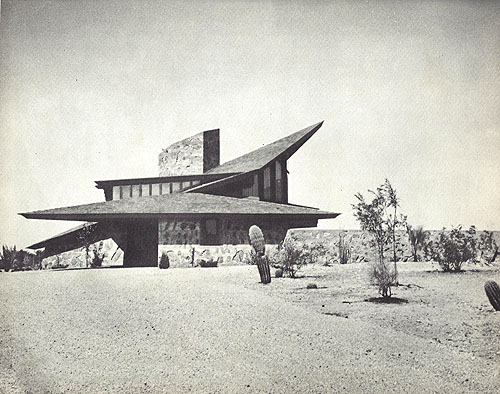 |
|
1) Jorgine Boomer Residence 1954, viewed
from the Southeast. First floor: The Work Space (kitchen) can be
seen on the far left, Entrance and Chauffeur's quarter in
the center, Sitting Room to the right, and the walled Lanai
on the right. Upper floor: Servant's (maid's) room is on the
left, stairway is in the center, the Sitting Room (Bedroom)
is on the right. The concrete masonry core houses the
bathrooms and fireplaces on the first and second floors, and
mimics the same angle of the large dramatic roof that
reaches skyward. Published in "The Natural House," 1954,
p.209. (Courtesy of Horizon Press, New
York and The Frank Lloyd Wright Foundation.) |
|
|
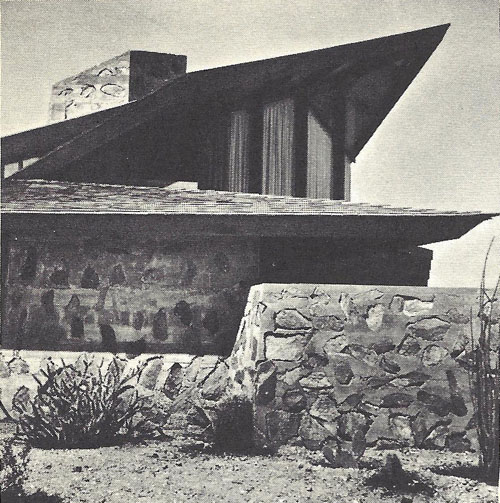 |
|
2) Jorgine Boomer Residence 1954, viewed
from the East. The walls are constructed of natural red
desert stone set in concrete. First floor: The Chauffeur's
quarter is on the left, the Sitting Room to the right, and
the walled Lanai on the far right. Upper floor: The stairway
is on the left, the Sitting Room (Bedroom) is on the right.
The concrete masonry core houses the bathrooms and fireplaces on the first and
second floors, and
mimics the same angle of the large dramatic roof that
reaches skyward. Published in "The Natural House," 1954,
p.210. (Courtesy of Horizon Press, New
York and The Frank Lloyd Wright Foundation.) |
|
|
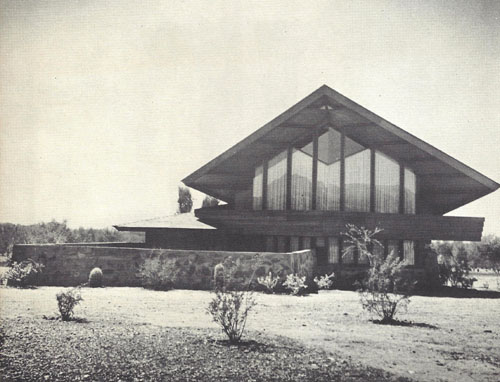 |
|
3) Jorgine Boomer Residence 1954, viewed
from the North. Glazed walls of glass reflect the mountain
views. Center and side angles are formed with mitered glass.
The walls are constructed of natural red desert stone set in
concrete. First floor: The walled Lanai on the far left and
foreground, the Chauffeur's quarter is on the left, the Sitting Room
in the center, the Bedroom is on the right. Upper floor:
Floor to ceiling glass encloses the Sitting Room (Bedroom).
Side doors open to the upper Balcony. Published in "The Natural House," 1954,
p.210. (Courtesy of Horizon Press, New
York and The Frank Lloyd Wright Foundation.) |
|
|
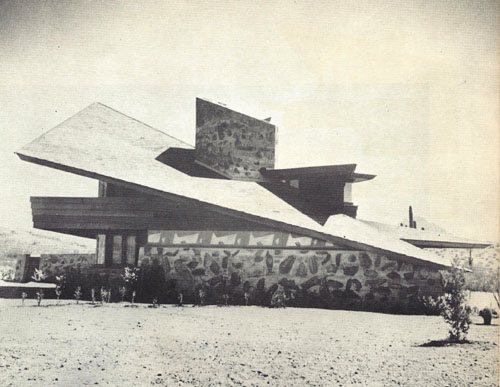 |
|
4) Jorgine Boomer Residence 1954, viewed
from the West. The walls are constructed of natural red
desert stone set in concrete. First floor: The walled Lanai
is on the far left, the Bedroom is on the left, the Dining Room
in the center, the Work Space is on the right. Perforated light screens add a measure of privacy to the Dining Room
and Work Space. Upper floor: The Balcony and Roof cantilever
out over the Lanai. The Sitting Room (Bedroom) is on the
left, the Servant's Room is on the right. Note the upper
window on the far right. Like the windows in the front of
the house, this window also has a mitered glass corner. The
concrete masonry core houses the bathrooms and fireplaces on the first and
second floors, and mimics the same angle of the large dramatic roof that
reaches skyward. Piestewa (Squaw) Peak can be
seen in the background. Published in "The Natural House," 1954,
p.211. (Courtesy of Horizon Press, New
York and The Frank Lloyd Wright Foundation.) |
|
|
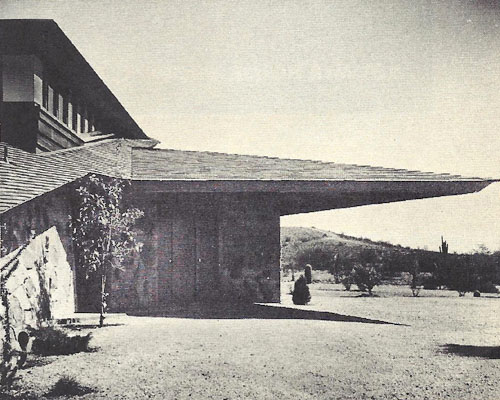 |
|
5) Jorgine Boomer Residence 1954, viewed
from the Southwest. First floor: The Work Space is in the
foreground on the left, the Entrance in the center, the
Chauffeur's quarter is below the wide cantilevered
overhanging eve on the right. Upper floor: The Servant's Room
and stairway is on the left. Note the upper window in the
foreground on the far left. Like the windows in the front of
the house, this window also has a mitered glass corner. Piestewa (Squaw) Peak can be
seen in the background. Published in "The Natural House," 1954,
p.211. (Courtesy of Horizon Press, New
York and The Frank Lloyd Wright Foundation.) |
|
|
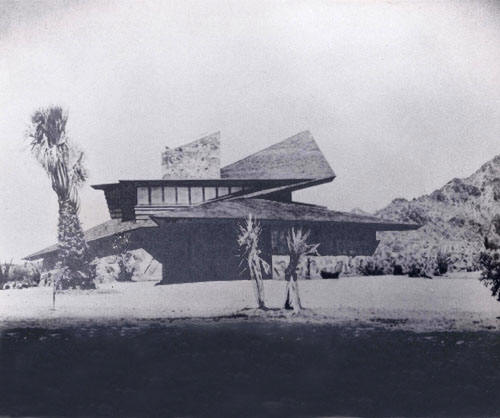 |
|
6) Jorgine Boomer Residence 1954, viewed
from the Southeast. First floor: The Work Space (kitchen)
can be seen on the far left, Entrance and Chauffeur's
quarter in the center, Sitting Room to the right, and the
walled Lanai on the far right. The walls are constructed of
natural red desert stone set in concrete. Upper floor:
Servant's (maid's) room is on the left, stairway is in the
center, the Sitting Room (Bedroom) is on the right. Note the
upper window on the far left. Like the windows in the front
of the house, this window also has a mitered glass corner.
The back two corners (left), angle outward as the wall rises
to the roof. The concrete masonry core houses the bathrooms and fireplaces on
the first and second floors, and mimics the same angle of the large dramatic roof. Piestewa (Squaw) Peak can be
seen in the background. Published in "The Natural
House," 1954, p.212. (Courtesy of Horizon Press, New
York and The Frank Lloyd Wright Foundation.) |
|
|
|
|
|
|
|
Jorgine Boomer Residence (1955) |
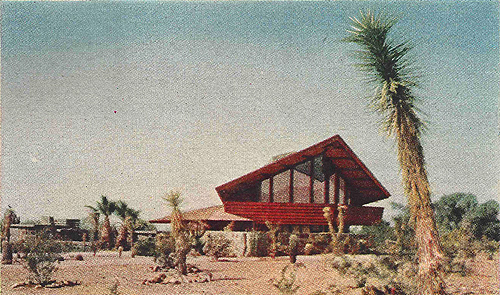 |
|
Published in
Time Magazine,
July 25, 1955. Caption: "Sunbonnet Roof, for comfortable
desert living, was designed by Architect
Frank Lloyd Wright to
protect this Phoenix house from glare and heat." The
Benjamin Adelman Residence can be seen in the background.
|
|
|
|
|
|
|
|
|
Jorgine Boomer Residence
(Circa 1956) |
|
Jorgine Boomer
Residence
Circa 1956. Set of four
photographs.
Image 1: A rare color photograph showing the natural
colors of wood and stone used in the
Boomer residence. The row of plantings on the left were
approximately 1-2 feet in the 1954 image number 4, published
in "The Natural House". They are now approximately 3 feet
tall, and in full bloom. The larger tree on the left, has also gained 2-3
feet which appears on the far right in the 1954 image. This
image also shows the original second floor, before the
expansion of the south end. The walls are constructed of natural red
desert stone set in concrete. First floor: The walled Lanai
is on the far left, the Dining Room and
Work Space in the center. Perforated light screens add a
measure of privacy |
|
to the Dining Room
and Work Space. The Entrance and Chauffeur's quarter are on
the right below the wide cantilevered overhanging eve. Upper floor: The Balcony and Roof cantilever
out over the Lanai. The Sitting Room (Bedroom) is on the
left, the Servant's Room is on the right. The concrete
masonry core houses the bathrooms and fireplaces on the first and
second floors, and mimics the same angle of the large dramatic roof that
reaches skyward. Piestewa (Squaw) Peak can be
seen in the background. Images #1-3 were published in
"Arizona Highways", image #4 was taken during the same
time frame, possibly at the same time. Photographer unknown. |
| |
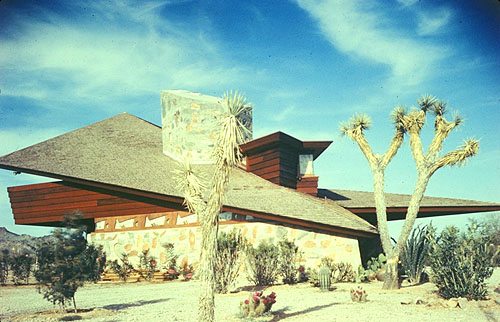 |
| 1) Jorgine Boomer
Residence Circa 1956, viewed
from the West. A rare color image showing the natural
colors of wood and stone used in the construction of the
Boomer residence. The row of plantings on the left were
approximately 1-2 feet in the 1954 image number 4, published
in "The Natural House". They are now approximately 3 feet
tall, and in full bloom. The larger tree on the left, has also gained 2-3
feet which appears on the far right in the 1954 image. This
image also shows the original second floor, before the
expansion of the south end (right). The walls are constructed of natural red
desert stone set in concrete. Piestewa (Squaw) Peak can be
seen in the background. Photographer unknown. |
| |
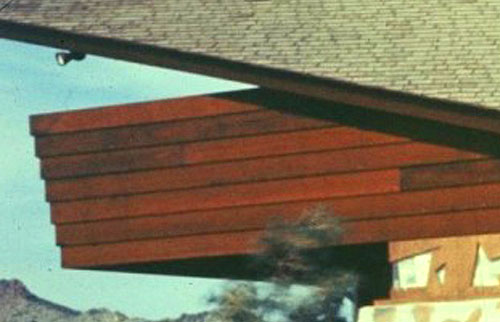 |
| 1B)
Detail: Jorgine Boomer Residence Circa 1956. A rare color
image showing the natural colors of wood and stone used in
the construction of the Boomer residence. The Balcony and Roof cantilever
out over the Lanai. The walls of the balcony lean outward as
the redwood planks overlap. Piestewa (Squaw) Peak can be
seen in the background. Photographer unknown. |
| |
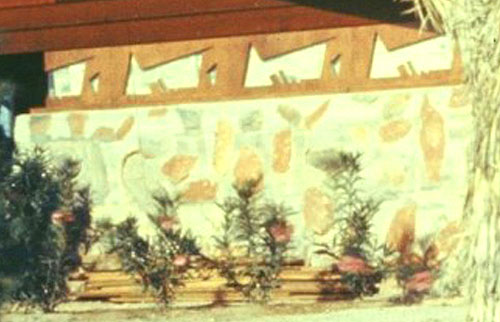 |
| 1C)
Detail: Jorgine Boomer Residence Circa 1956. The row of
plantings were approximately 1-2 feet in the 1954 image
number 4, published in "The Natural House". They are now
approximately 3 feet tall, and in full bloom. The walls are constructed of
natural red desert stone set in concrete. Perforated light screens add a measure of privacy to the Dining Room
and Work Space. Photographer unknown. |
| |
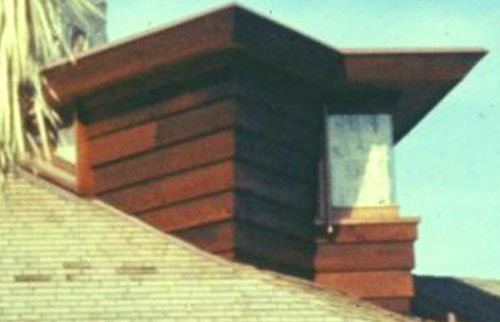 |
| 1D)
Detail: Jorgine Boomer Residence Circa 1956. The Servant's
(Maid's) room before the expansion. Like the windows in the
front of the house, the window on the right has a mitered glass corner.
Photographer unknown. |
| |
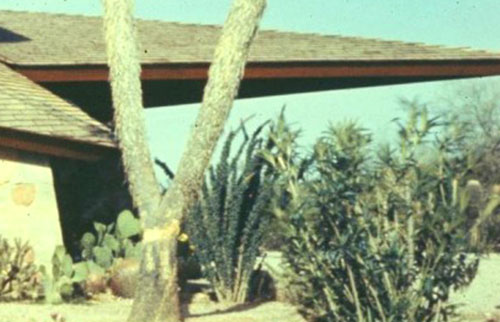 |
| 1E)
Detail: Jorgine Boomer Residence Circa 1956. The Entrance
and Chauffeur's quarter are below the wide cantilevered
overhanging eve. Photographer unknown. |
| |
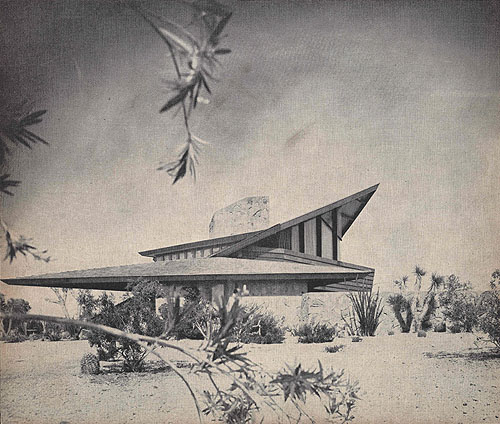 |
| 2)
Jorgine Boomer Residence Circa 1956. Viewed from the
Southeast. The walls are constructed of natural red desert
stone set in concrete. First floor: The Entrance and
Chauffeur's quarter are below the wide cantilevered
overhanging eve on the left, the Sitting Room is to the right,
and the walled Lanai is on the far right. Upper floor: The
Servant's Room is on the left, the stairway is in the center,
the Sitting Room (Bedroom) is on the right. The concrete
masonry core houses the bathrooms and fireplaces on the first
and second floors, and mimics the same angle of the large
dramatic roof. Courtesy of
Arizona Highways. Photographer unknown. |
| |
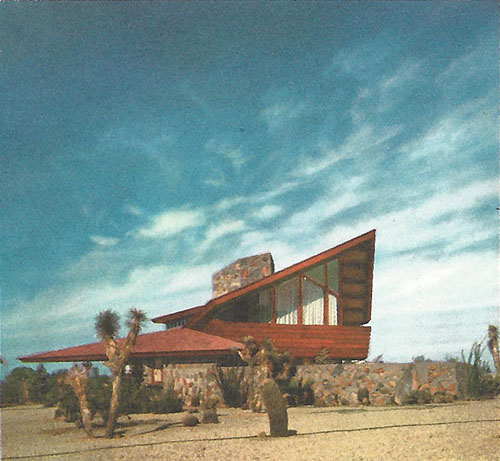 |
| 3)
Jorgine Boomer Residence Circa 1956. Viewed from the East.
The walls are constructed of natural red desert stone set in
concrete. First floor: The Entrance and Chauffeur's quarter
are below the wide cantilevered overhanging eve on the left,
the Sitting Room to the right, and the walled Lanai on the
far right. Upper floor: The Servant's Room is on the left,
stairway is in the center, the Sitting Room (Bedroom) is on
the right. The concrete masonry core houses the bathrooms and
fireplaces on the first and second floors, and mimics the
same angle of the large dramatic roof.
Courtesy of Arizona Highways. Photographer unknown. |
| |
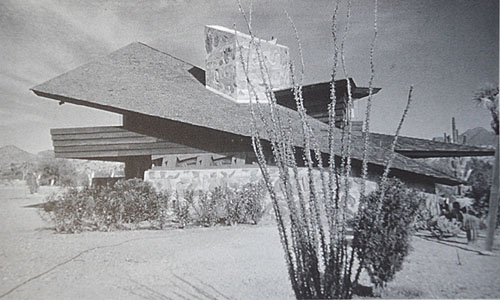 |
| 4) Jorgine
Boomer Residence Circa 1956, viewed from the West. The walls
are constructed of natural red desert stone set in concrete.
First floor: The Bedroom is on the left, the Dining Room in
the center, the Work Space is on the right. Perforated light
screens add a measure of privacy to the Dining Room and Work
Space. Upper floor: The Balcony and Roof cantilever out over
the Lanai. The Sitting Room (Bedroom) is on the left, the
Maid's Room (Bedroom) is on the right. Note the upper window
on the far right. Like the windows in the front of the
house, this window also has a mitered glass corner. The
concrete masonry core houses the bathrooms and fireplaces on
the first and second floors, and mimics the same angle of
the large dramatic roof that reaches skyward. Piestewa
(Squaw) Peak can be seen in the background. This image was
published in "The Seven Ages of Frank Lloyd Wright" Hoppen,
1993. Photographer unknown. |
|
|
Jorgine Boomer Residence
(1963) |
|
Jorgine Boomer Residence 1963,
viewed from the East. Nine years after the home was
completed, the existing foliage has grown, but still remains
sparse like the original 1954 images. The upper Sitting Room curtains have
been replaced. The Arizona Biltmore can be seen in the
background on the right. The south end of the upper level
has been greatly expanded. The walls are constructed of
natural red desert stone set in concrete. First floor: The
Entrance and Chauffeur's quarter are below the wide
cantilevered overhanging eve on the left, the Sitting Room
is to the right, and the walled Lanai on the far right.
Upper floor: The Servant's Room is on the left, stairway is
in the center, the Sitting Room (Bedroom) is on the right.
The concrete masonry core houses the bathrooms and fireplaces on
the first and second |
|
floors, and mimics the same angle of the large dramatic roof that
reaches skyward.
After living in the home for just a few
years, Boomer donated it to the Phoenix Art Museum. Unable
to utilize and maintain the property, the museum sold it to
Lucile Kinter (1910-2008). According to the Lucile's nephew,
the present owner of the home, beginning in 1958, Boomer
donated the home to the museum over a three year period
(1958, 1959 and 1960). Lucile purchased the home in 1961 and
lived in there until her death,
when it was passed on to the family.
This photograph is part of a
set of 12 - 2 1/4"
transparencies, each with the time stamp "Sept 63." Courtesy
of the Douglas M. Steiner collection. |
| |
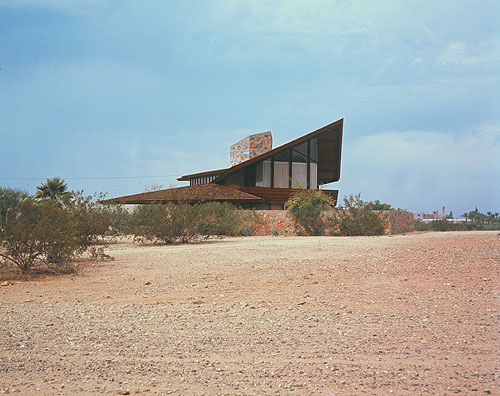 |
|
1) Jorgine Boomer Residence
1963, viewed from the East. Nine years after the home
was completed, the existing foliage has grown, but still
remains sparse like the original 1954 images. The upper
Sitting Room curtains have
been replaced. The Arizona Biltmore can be seen in the
background on the right. The south end of the upper level
has been greatly expanded. The walls are constructed of
natural red desert stone set in concrete. First floor: The
Entrance and Chauffeur's quarter are below the wide
cantilevered overhanging eve on the left, the Sitting Room
to the right, and the walled Lanai on the far right. Upper
floor: The Servant's Room is on the left, stairway is in the
center, the Sitting Room (Bedroom) is on the right. The
concrete masonry core houses
the bathrooms and fireplaces on the first and second floors,
and mimics the same angle of the large dramatic roof that
reaches skyward. |
| |
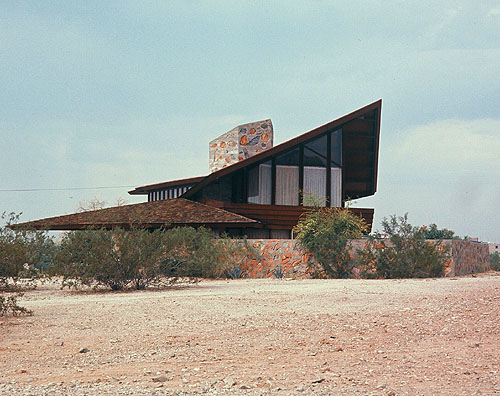 |
|
1B) Detail: Jorgine Boomer Residence
1963, viewed from the Northeast. Nine years after the home
was completed, the existing foliage has grown, but still
remains sparse like the original 1954 images. Living room curtains have
been replaced. The south end of the upper level
has been greatly expanded. The walls are constructed of
natural red desert stone set in concrete. First floor: The
Entrance and Chauffeur's quarter are below the wide
cantilevered overhanging eve on the left, the Sitting Room
is to the right, and the walled Lanai on the far right.
Upper floor: The Servant's Room is on the left, stairway is
in the center, the Sitting Room (Bedroom) is on the right.
The concrete masonry core houses
the bathrooms and fireplaces on the first and second floors,
and mimics the same angle of the large dramatic roof that
reaches skyward. |
| |
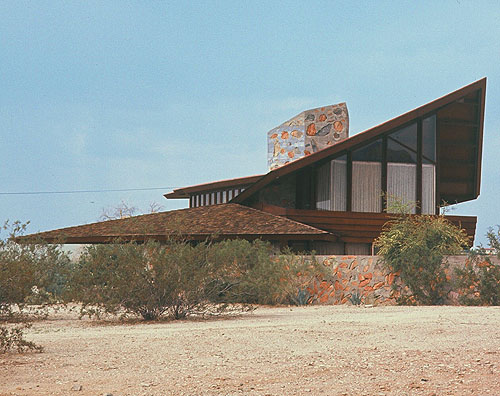 |
|
1C) Detail: Jorgine Boomer Residence
1963. Living room curtains have
been replaced. The south end of the upper level
has been greatly expanded. The walls are constructed of
natural red desert stone set in concrete. First floor: The
Entrance and Chauffeur's quarter are below the wide
cantilevered overhanging eve on the left, the Sitting Room
is to the right, and the walled Lanai on the far right.
Upper floor: The Servant's Room is on the left, stairway is
in the center, the Sitting Room (Bedroom) is on the right.
The concrete masonry core houses
the bathrooms and fireplaces on the first and second floors,
and mimics the same angle of the large dramatic roof that
reaches skyward. |
| |
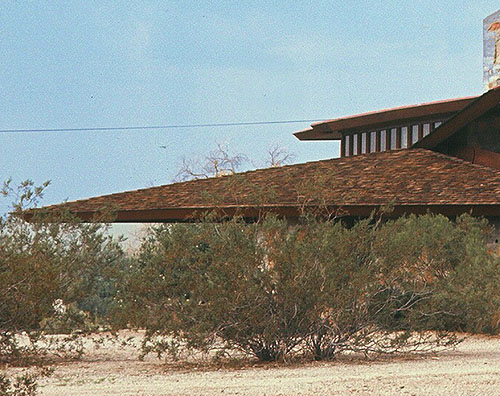 |
|
1D) Detail: Jorgine Boomer Residence
1963. First floor: The Entrance and Chauffeur's quarter are
below the wide cantilevered overhanging eve on the left, the Sitting Room
is on
the far right. Upper
floor: The Servant's Room is on the left and has been
greatly expanded, stairway is on the right. |
| |
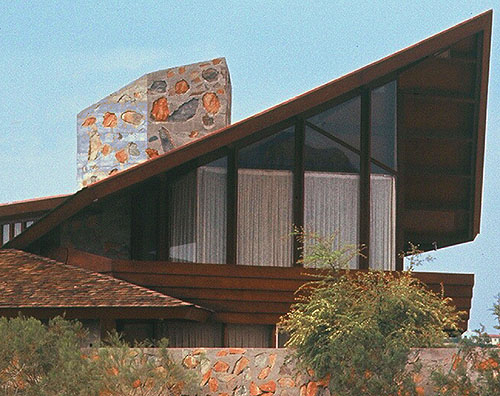 |
|
1E) Detail: Jorgine Boomer Residence
1963. The walls are constructed
of natural red desert stone set in concrete. First floor:
The Chauffeur's quarter and Entrance are on the left, the
Sitting Room to the right, and the walled Lanai is in the
foreground. Upper floor: The Servant's Room is on the left,
stairway is in the center, the Sitting Room (Bedroom) is on
the right. The concrete masonry core houses
the bathrooms and fireplaces on the first and second floors,
and mimics the same angle of the large dramatic roof that
reaches skyward. |
| |
| |
| |
|
|
Jorgine Boomer Residence
(Circa 1973-5) |
|
Jorgine Boomer Residence Circa
1973-5. This set of six photographs were photographed by
Yukio Futagawa. Five of the six were
published in the 1976, "Global
Interiors #10", p.148-51. 26 homes were photographed for
this volume. That would date these photographs prior to
1976. The automobile parked in the driveway on the left (in
image #1) is a 1959 Buick Electra. Looking at the landscaping, the foliage
could easily be 20 years old, when comparing it to the
landscaping from 1953 and 1963. Image #2 was published in "Frank
Lloyd Wright Monograph 1951-1959" Volume 8, 1988. The upper sitting room curtains have
been replaced again, following the original 1953 format, but
the interior photographs were shot at an earlier date, when
the curtains |
|
hung from a horizontal bar. The
south end of the upper level
has been greatly expanded. The wall forming the
bedroom on the lower level has been removed, enlarging the
living room. The walls are constructed
of natural red desert stone set in concrete. First floor:
The Entrance and Chauffeur's quarter are below the wide
cantilevered overhanging eve on the left, the Sitting Room
is to the right, and the walled Lanai on the far right.
Upper floor: The Servant's Room is on the left, stairway is
in the center, the Sitting Room (Bedroom) is on the right.
The concrete masonry core houses
the bathrooms and fireplaces on the first and second floors,
and mimics the same angle of the large dramatic roof that
reaches skyward. |
| |
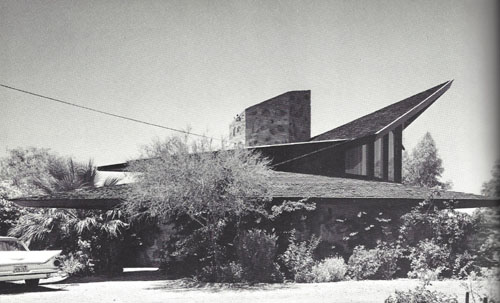 |
|
1) Jorgine Boomer Residence
Circa 1973-5, viewed from the Southeast. Photographed by Yukio Futagawa and
published in the 1976, "Global
Interiors #10". The automobile parked in the driveway on the left is a
1959 Buick Electra. The upper sitting room curtains have
been replaced again, following the original 1953 format. The south end of the upper level
has been greatly expanded. The walls are constructed
of natural red desert stone set in concrete. First floor:
The Entrance and Chauffeur's quarter are below the wide
cantilevered overhanging eve on the left, the Sitting Room
is to the right, and the walled Lanai on the far right.
Upper floor: The Servant's Room is on the left, stairway is
in the center, the Sitting Room (Bedroom) is on the right.
The concrete masonry core houses
the bathrooms and fireplaces on the first and second floors,
and mimics the same angle of the large dramatic roof. (Courtesy of A. D. A. Edita.) |
| . |
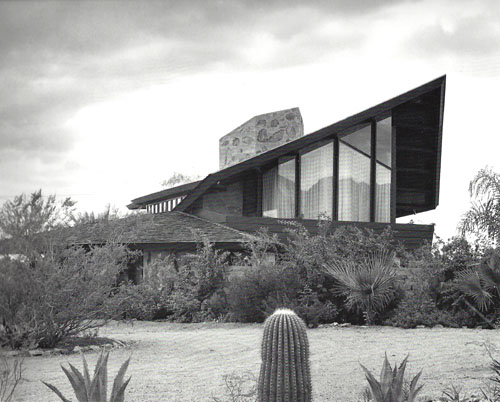 |
| 2) Jorgine Boomer Residence
Circa 1973-5, viewed from the East. Photographed by Yukio Futagawa and
published in the 1988, "Frank
Lloyd Wright Monograph 1951-1959". The upper sitting
room curtains have
been replaced again, following the original 1953 format. The south end of the upper level
has been greatly expanded. The walls are constructed
of natural red desert stone set in concrete. First floor:
The Entrance and Chauffeur's quarter are below the wide
cantilevered overhanging eve on the left, the Sitting Room
is to the right, and the walled Lanai on the far right.
Upper floor: The Servant's Room is on the left, stairway is
in the center, the Sitting Room (Bedroom) is on the right.
The concrete masonry core houses
the bathrooms and fireplaces on the first and second floors,
and mimics the same angle of the large dramatic roof. (Courtesy of A. D. A. Edita.) |
| |
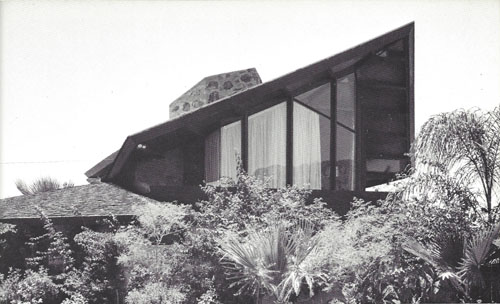 |
| 3) Jorgine Boomer Residence
Circa 1973-5, viewed from the East. Photographed by Yukio Futagawa and
published in the 1976, "Global
Interiors #10". The upper sitting room curtains have
been replaced again, following the original 1953 format. The south end of the upper level
has been greatly expanded. The walls are constructed
of natural red desert stone set in concrete. First floor:
The Entrance and Chauffeur's quarter are below the wide
cantilevered overhanging eve on the left, the Sitting Room
is to the right, and the walled Lanai on the far right.
Upper floor: The Servant's Room is on the left, stairway is
in the center, the Sitting Room (Bedroom) is on the right.
The concrete masonry core houses
the bathrooms and fireplaces on the first and second floors,
and mimics the same angle of the large dramatic roof. (Courtesy of A. D. A. Edita.) |
| |
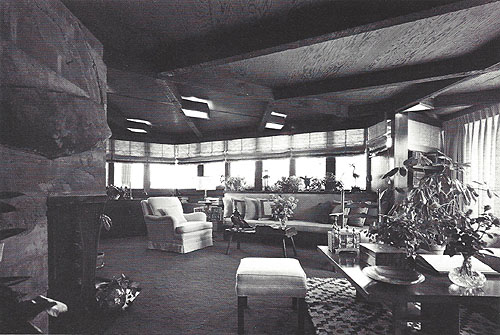 |
| 4) Jorgine
Boomer Residence Circa 1973-5, viewed from the stairs. Photographed by Yukio Futagawa and
published in the 1976, "Global
Interiors #10". Also published in "Frank
Lloyd Wright Monograph 1951-1959", 1988. The fireplace
on the left is constructed of natural red desert stone set
in concrete. The wall that formed the lower level
bedroom has been removed, enlarging the
living room. The floor to ceiling doors on the right lead
out to the Lania. (Courtesy of A. D. A. Edita.) |
| |
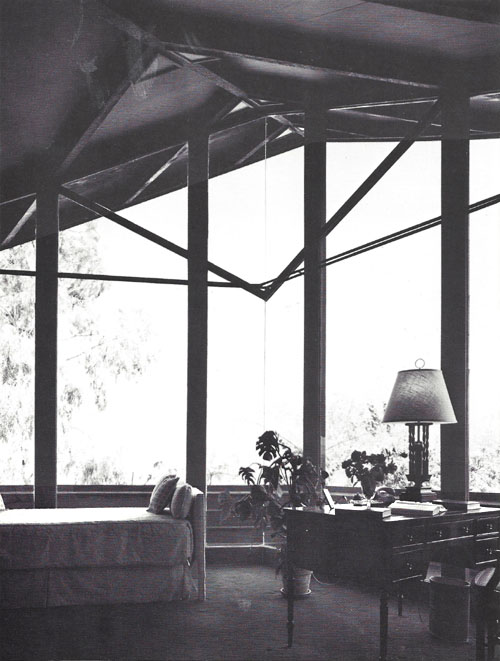 |
| 5) Jorgine
Boomer Residence Circa 1973-5, view looking North. Photographed by Yukio Futagawa and
published in the 1976, "Global
Interiors #10". Also published in "Frank
Lloyd Wright Monograph 1951-1959", 1988. In the
exterior photographs, the upper sitting room curtains had
been replaced, following the original 1953 format, but this
interior photographs were shot at an earlier date, when the
curtains hung from a horizontal bar similar to the 1963
photograph. This Northern wall is constructed of wood and
floor to ceiling glass. The center angle is formed with mitered
glass. (Courtesy of A. D. A. Edita.) |
| |
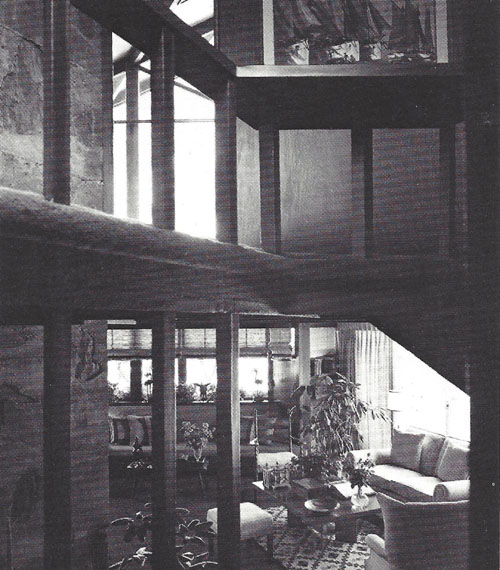 |
| 6) Jorgine Boomer Residence
Circa 1973-5, viewed from the stairway looking North. Photographed by Yukio Futagawa and
published in the 1976, "Global
Interiors #10". The concrete masonry core on the
left houses
the bathrooms and fireplaces on the first and second floors
and is constructed of natural red desert stone set in
concrete. The floor to ceiling doors on the right lead out
to the Lania. (Courtesy of A. D. A. Edita.) |
| |
| |
| |
|
|
Jorgine Boomer Residence Exterior (2004) |
|
On a trip to
Scottsdale during the
spring of 2004, we had the opportunity to drive past the
Boomer residence and take a few photographs. After 50 years,
the home appeared to be engulfed by desert foliage which was
in full bloom.
The home is dominated by the large roof
that begins in the rear of the home about three to four feet off the
ground, and rises to the front, overshadowing the two story home
in front, then cantilevers out over the balcony and lanai.
The home is anchored to the desert with
walls that are constructed of natural red desert stone set
in concrete, in the nature of Taliesin West, which Frank
Lloyd Wright began in 1937. The two story home is just over 1,400
square feet. The lower |
|
level
includes the Living Room, Kitchen and Dining area, Bath and
what was designed as the Chauffeur's quarter. A bedroom wall
was removed, enlarging the Living Room. The upper level
includes a large Bedroom, Bath and what was designed as the
Maid's Bedroom.
After living in the home for just a few
years, Boomer donated it to the Phoenix Art Museum which
sold it to Lucile Clarina Medcraft Kinter. She was
born on March 31, 1910 and passed away on November
16, 2008 at the age of 98. She was married to Charles V. Kinter.
In 2004, she would have been 94 years old, which might
explain the state of the landscape. Photographed by Douglas M.
Steiner, April, 2004. |
|
|
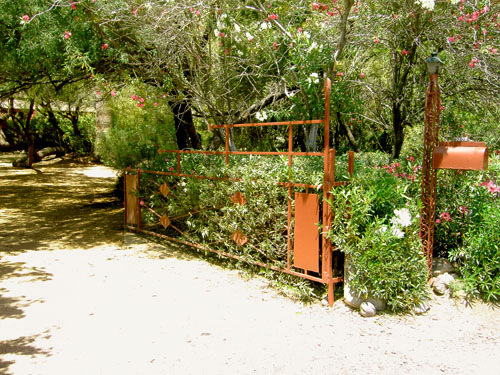 |
|
1) Jorgine Boomer Residence
entrance gate April 26, 2004. (ST#2004.40.1014-1) |
|
|
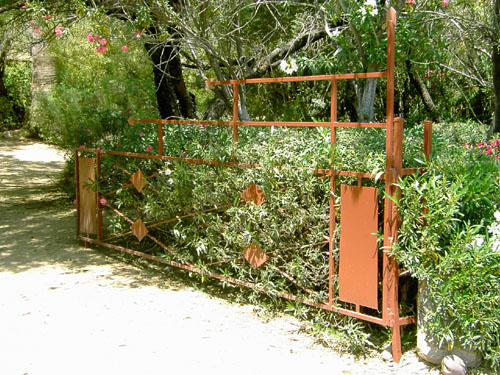 |
|
1B) Detail: Jorgine Boomer
Residence entrance gate, April 26, 2004.
(ST#2004.40.1014-1B) |
|
|
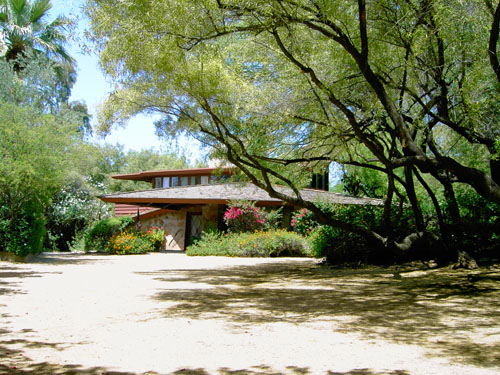 |
|
2) Jorgine Boomer Residence
viewed from the Southeast, April 26, 2004. The home is engulfed
by desert foliage which was in full bloom. The home is
anchored to the desert with walls that are constructed of
natural red desert stone set in concrete, in the nature of
Taliesin West. First floor: The Entrance and Chauffeur's
quarter are in the center, the Sitting Room is to the right.
Upper floor: The Servant's (Maid's) Bedroom and Balcony on the
left has been greatly expanded. The stairway is in the
center, the Sitting Room (Bedroom) is on the right. The
concrete masonry core houses the bathrooms and fireplaces on
the first and second floors, and mimics the same angle of
the large dramatic roof that reaches skyward.
(ST#2004.40.1014-2) |
|
|
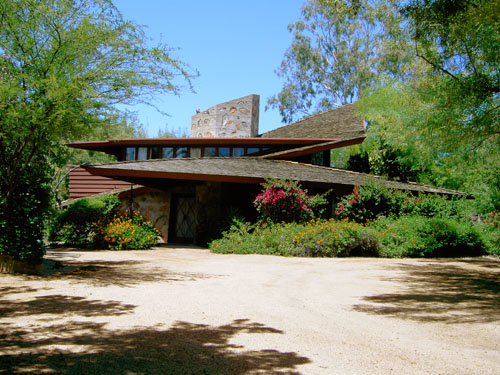 |
|
3) Jorgine Boomer Residence
viewed from the Southeast, April 26, 2004. The desert foliage is
in full bloom. The home is anchored to the desert with walls
that are constructed of natural red desert stone set in
concrete. First floor: The Work Space (Kitchen) is on the
left. Entrance and Chauffeur's quarter are in the center,
the Sitting Room is to the right. Upper floor: The Servant's
(Maid's) Bedroom and Balcony on the left has been greatly
expanded. The Balcony on the left was not part of the
original design. The stairway is in the center, the Sitting
Room (Bedroom) is on the right. The concrete masonry core
houses the bathrooms and fireplaces on the first and second
floors, and mimics the same angle of the large dramatic roof
that reaches skyward. (ST#2004.40.1014-3) |
|
|
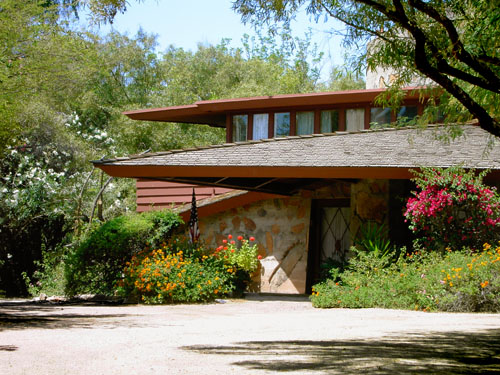 |
|
4) Jorgine Boomer Residence
viewed from the Southeast, April 26, 2004. The desert foliage is
in full bloom. The home is anchored to the desert with walls
that are constructed of natural red desert stone set in
concrete. First floor: The Work Space (Kitchen) is on the
left. Entrance and Chauffeur's quarter are on the right.
Upper floor: The Servant's (Maid's) Bedroom and Balcony on the
left has been greatly expanded. The Balcony on the left was
not part of the original design. (ST#2004.40.1014-4) |
|
|
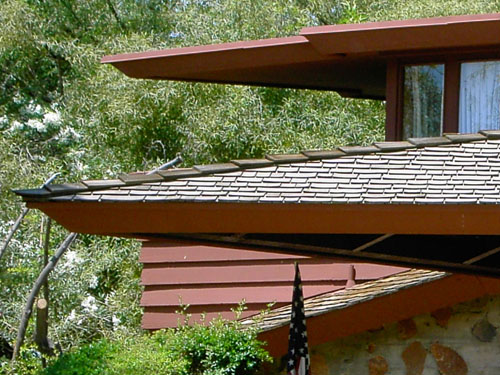 |
|
4B) Detail upper floor: The
Servant's (maid's) room and Balcony has been greatly
expanded. The Balcony on the left was not part of the
original design. Unlike the original balcony in front, the
walls of this balcony do not lean outward as the planks
overlap upward. And, unlike the original corner window and
the corner windows in the front of the house, this window
does not have a mitered glass corner. Although the upper
roof is cantilevered like the lower roof, it originally
formed an inward "V" with the tops of the "V" pointing
outward. It now forms a "V" with the bottom pointing
outward. (ST#2004.40.1014-4B) |
|
|
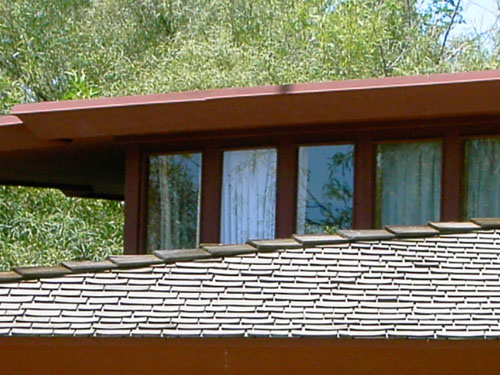 |
|
4C) Detail upper floor: The
Servant's (Maid's) Bedroom has been greatly expanded. The last
two windows on the left were added, and unlike the original
corner window, this window does not have a mitered glass
corner. (ST#2004.40.1014-4C) |
|
|
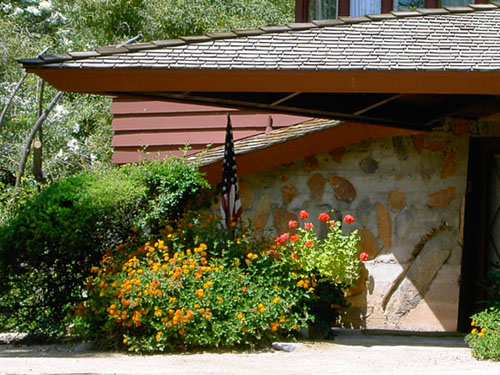 |
|
4D) Detail first floor: The
desert foliage is in full bloom. Exterior wall of the Work
Space (Kitchen). The Entrance is to the right.
(ST#2004.40.1014-4D) |
|
|
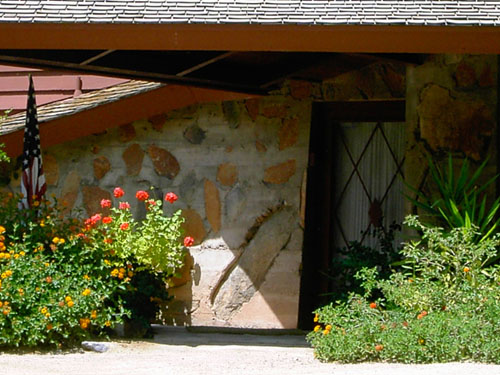 |
|
4E) Detail first floor: Walls
are constructed of natural red desert stone set in concrete.
The Work Space (Kitchen) is on the left, the Entrance is to
the right. The Chauffeur's quarter is on the far right.
(ST#2004.40.1014-4E) |
|
|
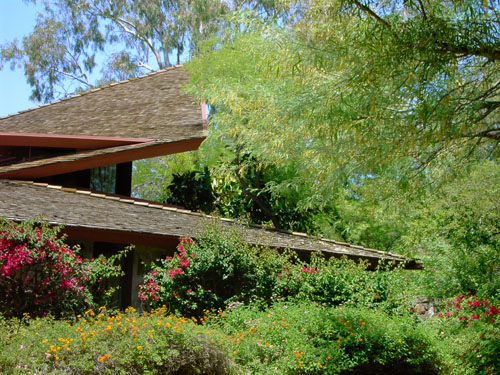 |
|
5) Jorgine Boomer Residence
viewed from the Southeast, April 26, 2004. The desert
foliage is in full bloom. First floor: The Chauffeur's
quarter is on the left, the Lanai is to the right. Upper
floor: The Sitting Room (Bedroom) is on the left. The home
is dominated by the large roof that begins in the rear of
the home and rises to the
front, overshadowing the two story home in front, then
cantilevers out over the balcony and lanai. (ST#2004.40.1014-5) |
|
|
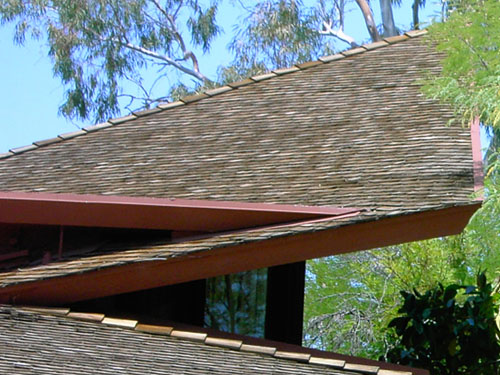 |
|
5B) Detail upper floor: The
Sitting Room (Bedroom) is on the left. The home is dominated
by the large roof that begins in the rear of the home and rises to the front,
overshadowing the two story home in front, then cantilevers out over the
balcony and lanai. (ST#2004.40.1014-5B) |
|
|
|
|
|
|
|
|
Jorgine Boomer Residence Exterior
(2014) |
|
My how time
flies. It had been ten years since we last visited
Scottsdale. This trip had three purposes. The first was to
visit our youngest son and his wife, who now lived in the
Phoenix area. The second was to visit Taliesin West and
personally meet and thank those that had assisted us in
publishing "Frank Lloyd Wright's
Nakoma Clubhouse & Sculptures." The third was a
desire to study and document Frank Lloyd Wright's work. in a
more in-depth way then just the cursory drive by, clicking a
few quick pictures (like in 2004).
We had that opportunity at
the Boomer Residence. The nephew of the second and longest
owner of the home, was very gracious and allowed us not only to
closely view the exterior, but also the interior.
As we approached the home from the east,
the first thing that became apparent was the extreme
measures that had been taken to reduce the desert growth
which had engulfed the property and the home ten years
earlier. Fifty years of growth |
|
had created a dense
forest.
The most stunning view of the exterior of
the home is from the Northwest (#11),
which exemplifies much of Wright's designs. The home is
anchored to the desert with walls that are constructed of
natural red desert stone set in concrete, in the nature of
Taliesin West. The concrete walls of the Sitting Room and
Work Space slant inward, while the Balcony walls slant
outward. Perforated light screens top the walls of the
Dining and Work Space, adding a measure of privacy. The home
is dominated by the large roof that begins in the rear of
the home, a few feet off the ground and rises, enhancing the
two story home in front, then cantilevers out over the
cantilevered balcony. There are three mitered glass corners
on the upper level, two on the lower. Floor to ceiling
windows and doors on the first and second level enhances the
natural light.
Set of 24 exterior and
24 interior photographs by Douglas M.
Steiner, April 2014 |
|
|
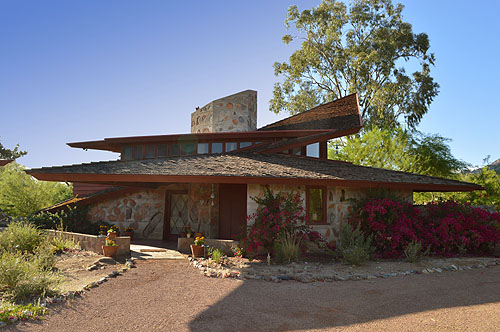 |
|
1) Jorgine Boomer Residence
viewed from the Southeast, April 15, 2014. Since last viewed in
2004, extreme measure have been
taken to trim the desert foliage which had engulfed the
home. The home is anchored to the desert with walls that are
constructed of natural red desert stone set in concrete, in
the nature of Taliesin West. First floor: The Work Space
(Kitchen) is on the left, Entrance and Chauffeur's quarter
are in the center, the Sitting Room is to the right. The walls
of the Lanai are on the far right. Upper floor: The
Servant's (Maid's) Bedroom and Balcony on the left has been
greatly expanded. The stairway is in the center, the Sitting
Room (Bedroom) is on the right. The concrete masonry core
houses the bathrooms and fireplaces on the first and second
floors, and mimics the same angle of the large dramatic roof
that reaches skyward. (ST#2014.07.1014-1) |
| |
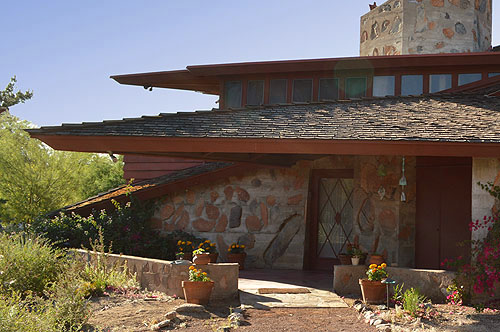 |
|
1B) Detail South end: First floor: The Work Space
(Kitchen) is on the left, the Entrance is in the center and Chauffeur's quarter
is on the right. Upper floor: The original Servant's
(Maid's) Bedroom on the left has been greatly expanded. There
is an addition of two windows and a balcony. The concrete
masonry core houses the bathrooms and fireplaces on the first and second
floors. (ST#2014.07.1014-1B) |
| |
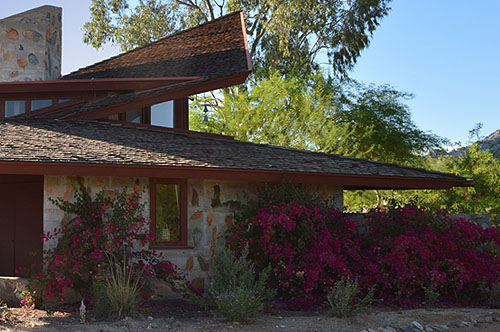 |
|
1C) Detail North end:
First floor: The Chauffeur's quarter is on the left, the
Sitting Room is in the center. The walls of the Lanai are on
the far right. Upper floor: The Sitting Room (Bedroom) is on
the left. The concrete masonry core houses the bathrooms and
fireplaces on the first and second floors, and mimics the
same angle of the large dramatic roof that reaches skyward. (ST#2014.07.1014-1C) |
| |
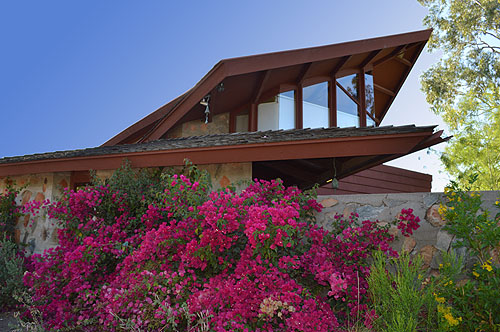 |
| 2) Jorgine
Boomer Residence viewed from the East, April 15, 2014. The
home is anchored to the desert with walls that are
constructed of natural red desert stone set in concrete.
First floor: The Chauffeur's quarter is on the left, the
walls of the Lanai are on the far right. Upper floor: The
home is dominated by the large roof that rises, enhancing the
two story home in front, then cantilevers out over the
balcony and lanai. Floor to ceiling windows cover two walls
of the Sitting Room (Bedroom). Three glass corners are
mitered. (ST#2014.07.1014-2) |
| |
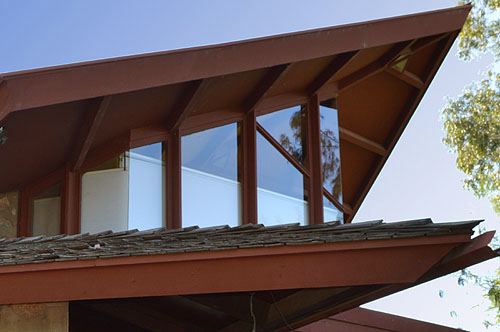 |
| 2B)
Detail upper floor: The home is dominated by the large roof
that rises, enhancing the two story home in front, then
cantilevers out over the balcony and lanai. Floor to ceiling
windows cover two walls of the Sitting Room (Bedroom). Three
glass corners are mitered. (ST#2014.07.1014-2B) |
| |
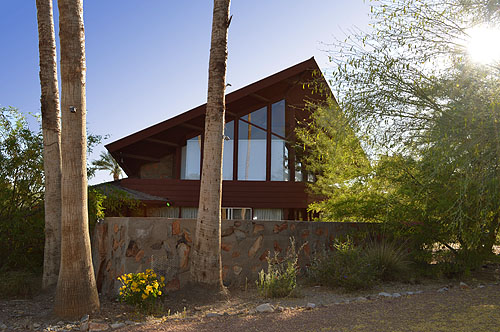 |
| 3) Jorgine
Boomer Residence viewed from the Northeast, outside the
Lanai, April 15, 2014. The Lanai walls are constructed of
natural red desert stone set in concrete. First floor: The
Chauffeur's quarter is on the left, the Sitting Room is in
the center. Upper floor: The stairway is to the left. Floor
to ceiling windows cover two walls of the Sitting Room
(Bedroom). Three glass corners are mitered. Doors to the left
and right of the glass walls open out to the Balcony. Note:
these three palm trees
were first visible in the circa 1973-5 images (#2), which
would make them approximately 40 years old. (ST#2014.07.1014-3) |
| |
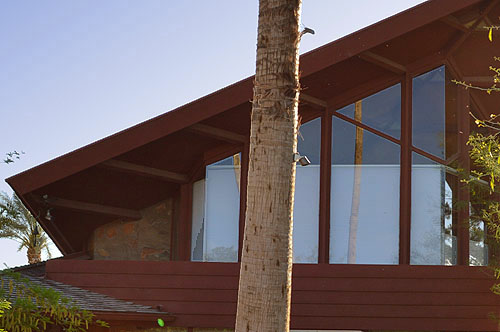 |
| 3B)
Detail upper floor: The stairway is to the left. Floor to
ceiling windows cover two walls of the Sitting Room
(Bedroom). Three glass corners are mitered. Doors to the left
and right of the glass walls open out to the Balcony.
(ST#2014.07.1014-3B) |
| |
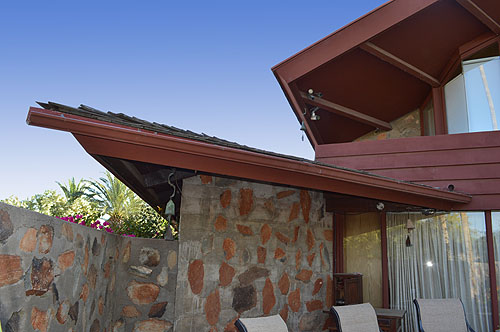 |
| 4) Jorgine
Boomer Residence viewed from the Northeast, inside the
Lanai, April 15, 2014. First floor: The walls of the Lanai
and Chauffeur's quarter on the left, are constructed of
natural red desert stone set in concrete. Floor to ceiling
windows and doors cover the Northeast wall of the Sitting
Room on the right. Upper floor: A door to the left of the
glass wall opens out to the Balcony. (ST#2014.07.1014-4) |
| |
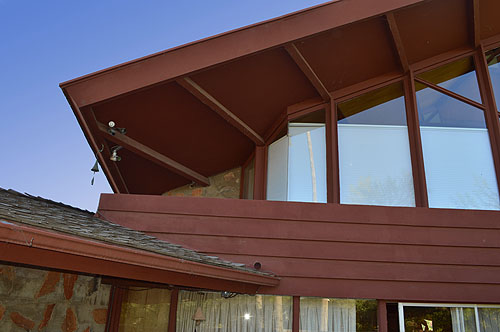 |
| 5) Jorgine Boomer Residence viewed from the Northeast, inside
the Lanai, April 15, 2014. Upper floor: Frank Lloyd Wright
designed the Boomer Residence on an equilateral parallelogram
diamond grid. The grid is visible in the pattern formed in
the open rafters of the roof. Floor to ceiling windows cover
two walls of the Sitting Room (Bedroom). Three glass corners
are mitered. A door to the left of the glass wall opens out
to the Balcony. (ST#2014.07.1014-5) |
| |
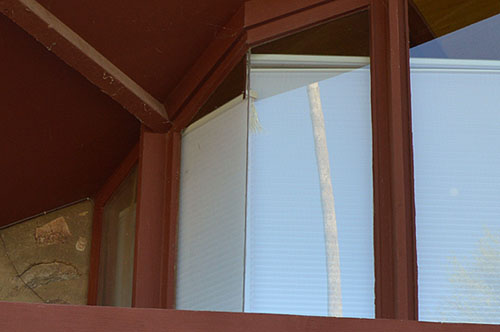 |
| 5B)
Detail of the Sitting Room's mitered glass corner. A door to
the left of the glass wall opens out to the Balcony. The
stairway's concrete wall is on the far left.
(ST#2014.07.1014-5B) |
| |
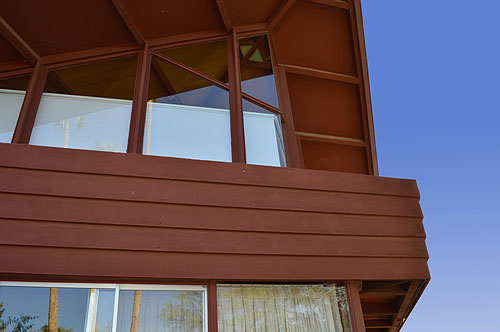 |
| 6) Jorgine
Boomer Residence viewed from the Northeast, inside the
Lanai, April 15, 2014. Upper floor: Frank Lloyd Wright
designed the Boomer Residence on an equilateral parallelogram
diamond grid. The grid is visible in the pattern formed in
the open rafters of the roof. Floor to ceiling windows cover
two walls of the Sitting Room (Bedroom). Three glass corners
are mitered. (ST#2014.07.1014-6) |
| |
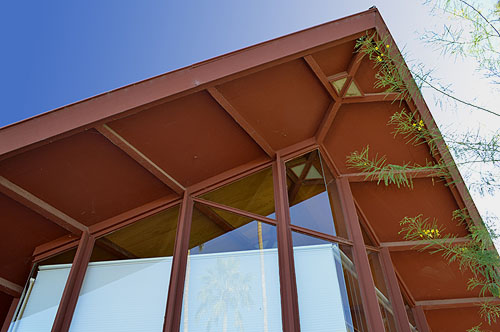 |
| 7) Jorgine
Boomer Residence viewed from the Northeast, inside the
Lanai, April 15, 2014. Upper floor: Frank Lloyd Wright
designed the Boomer Residence on an equilateral parallelogram
diamond grid. The grid is visible in the pattern formed in
the open rafters of the roof. The sets of ceiling lights
form diamonds, as does the window shape in the center at the
top. Center glass corners are mitered. (ST#2014.07.1014-7) |
| |
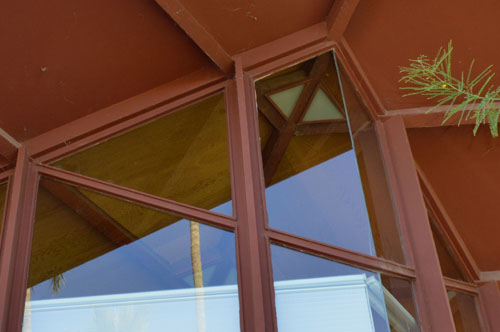 |
| 7B)
Detail of the diamond shape in the window and the set of
ceiling lights. Center glass corners are mitered.
(ST#2014.07.1014-7B) |
| |
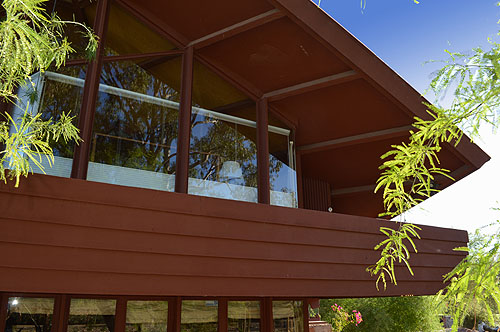 |
| 8) Jorgine
Boomer Residence viewed from the Northeast, April 15, 2014.
Upper floor: View of the right side of the Sitting Room.
Floor to ceiling windows cover two walls. The roof
cantilevers out over the Balcony, which cantilevers out over
the Lanai and desert floor. The diamond grid is in the pattern formed in the
open rafters of the roof. (ST#2014.07.1014-8) |
| |
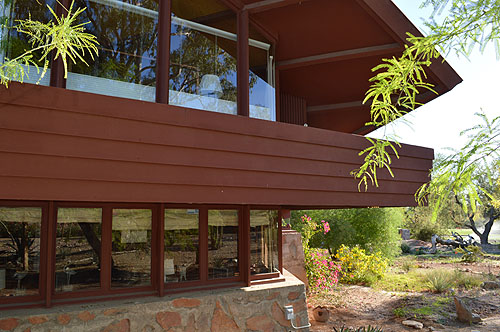 |
| 9) Jorgine
Boomer Residence viewed from the Northeast, April 15, 2014.
The home is anchored to the desert with walls that are
constructed of natural red desert stone set in concrete, in
the nature of Taliesin West. The concrete walls slant
inward, while the Balcony walls slant outward. First floor: The Sitting Room
(Living Room) is to the left, an original Bedroom was on the
right. The wall was removed, enlarging the Sitting Room. Upper floor: View of the
right side of the Sitting Room. Floor to ceiling windows
cover two walls. The roof cantilevers out over the Balcony,
which cantilevers out over the Lanai and desert floor. (ST#2014.07.1014-9) |
| |
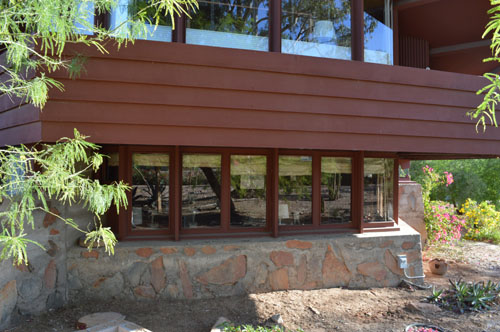 |
| 10)
Jorgine Boomer Residence viewed from the Northeast, April
15, 2014. The home is anchored to the desert with walls that
are constructed of natural red desert stone set in concrete.
The concrete walls slant inward, while the Balcony walls slant
outward. First floor: The Sitting Room (Living Room) is to
the left, an original Bedroom was on the right. The wall was
removed, enlarging the Sitting Room.
(ST#2014.07.1014-10) |
|
11 |
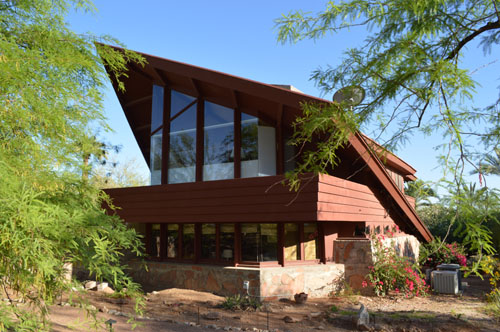 |
| 11)
Jorgine Boomer Residence viewed from the Northwest, April
15, 2014. First floor: The Sitting Room (Living Room) is to
the left, an original Bedroom was in the center, the Dining
Area and Work Space (Kitchen) are on the right. The wall was
removed, enlarging the Sitting Room. Two glass corners are
mitered on the lower level. Perforated light screens top the
walls of the Dining and Work Space, adding a measure of
privacy. Upper floor: Floor to ceiling windows
cover two full walls and part of two sides of the Sitting
Room (Bedroom). Three glass corners are mitered on the upper
level. Doors on either side of the Sitting Room lead out to
the Balcony. The expanded upper level to the right of the
roof line was added prior to 1963. The concrete walls of the
Sitting Room and Work Space slant inward, the Balcony walls
slant outward. The home is dominated by the large roof that
begins in the rear of the home, a few feet off the ground and rises,
enhancing the two
story home in front, then cantilevers out over the
cantilevered balcony. (ST#2014.07.1014-11) |
| |
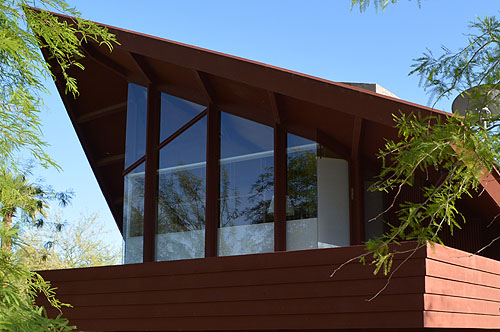 |
| 11B)
Detail upper level: Floor to ceiling windows
cover two full walls and part of two sides of the Sitting
Room (Bedroom). Three glass corners are mitered on the upper
level. Doors on either side of the Sitting Room lead out to
the Balcony. The Balcony walls slant outward. The home is
dominated by the large roof that begins in the rear of the
home and rises, enhancing the two story home in front, then
cantilevers out over the cantilevered balcony.
(ST#2014.07.1014-11B) |
| |
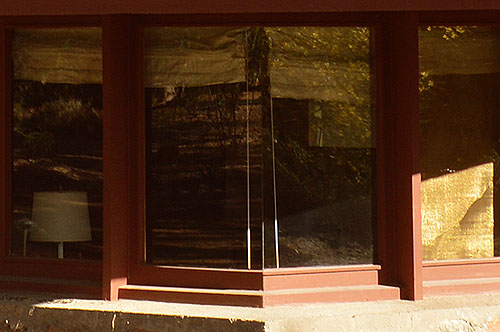 |
| 11C)
Detail of the mitered glass corner of the lower level.
(ST#2014.07.1014-11C) |
| |
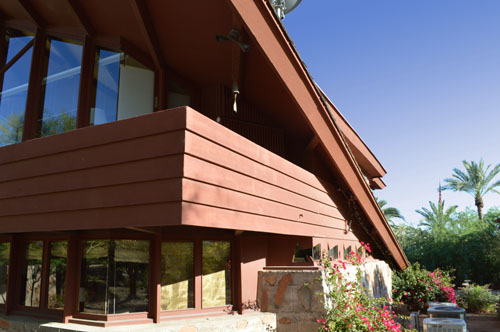 |
| 12)
Jorgine Boomer Residence viewed from the Northwest, April
15, 2014. First floor: The Sitting Room (Living Room) is to
the left, the Dining Area and Work Space (Kitchen) are on
the right. Two mitered glass corners are on the lower level.
Perforated light screens top the walls of the Dining and
Work Space, adding a measure of privacy. The concrete walls
of the Sitting Room and Work Space slant inward, while the Balcony
walls slant outward. (ST#2014.07.1014-12) |
|
|
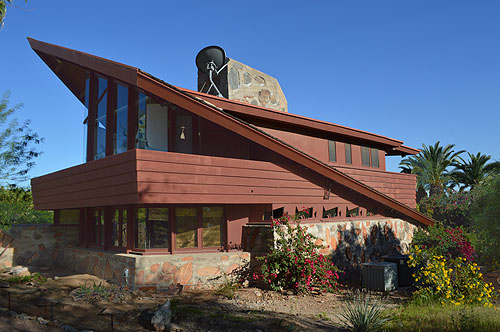 |
| 13)
Jorgine Boomer Residence viewed from the Northwest, April
15, 2014. First floor: The Lanai is on the far left. The
Sitting Room (Living Room) is to the left, the Dining Area
and Work Space (Kitchen) are on the right. Two glass corners
are mitered on the lower level. Perforated light screens top
the walls of the Dining and Work Space, adding a measure of
privacy. Upper floor: Floor to ceiling windows cover two
full walls and part of two sides of the Sitting Room
(Bedroom). Three glass corners are mitered on the upper
level. Doors on either side of the Sitting Room lead out to
the Balcony. The expanded upper level to the right of the
roof line was added prior to 1963. The concrete walls of the
Sitting Room and Work Space slant inward, the Balcony walls
slant outward. The home is dominated by the large roof that
begins in the rear of the home and rises, enhancing the
two story home in front, then cantilevers out over the
cantilevered balcony. The concrete masonry core houses the
bathrooms and fireplaces on the first and second floors,
and mimics the same angle of the roof.
(ST#2014.07.1014-13) |
| |
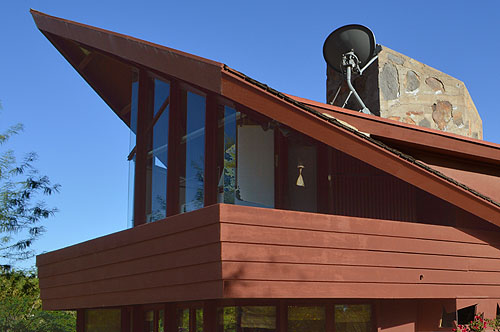 |
| 13B)
Detail of the upper level. Floor to ceiling windows cover
two full walls and part of two sides of the Sitting Room
(Bedroom). Three glass corners are mitered on the upper
level. Doors on either side of the Sitting Room lead out to
the Balcony. The expanded upper level to the right of the
roof line was added prior to 1963. The Balcony walls slant
outward. The home is dominated by the large roof that begins
in the rear of the home and rises, enhancing the two
story home in front, then cantilevers out over the
cantilevered balcony. The concrete masonry core houses the bathrooms and
fireplaces on the first and second floors, and mimics the
same angle of the roof.
(ST#2014.07.1014-13B) |
| |
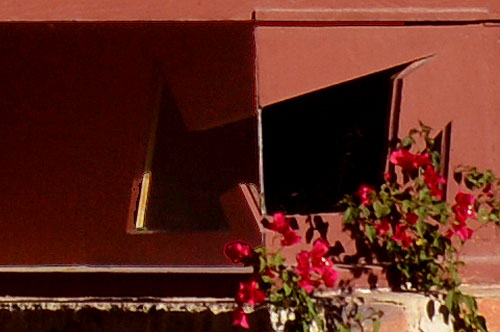 |
| 13C)
Detail of the mitered glass corner of the perforated light
screen in the Dining area. (ST#2014.07.1014-13C) |
| |
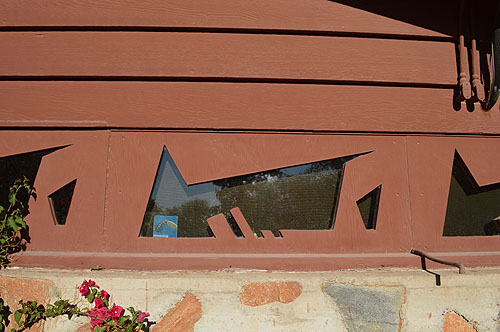 |
| 14)
Jorgine Boomer Residence April 15, 2014. Perforated light
screens top the walls of the Dining and Work Space, adding a
measure of privacy. (ST#2014.07.1014-14) |
| |
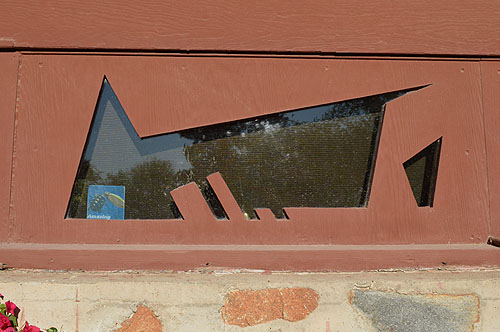 |
| 14B)
Detail of the perforated light screen. (ST#2014.07.1014-14B) |
| |
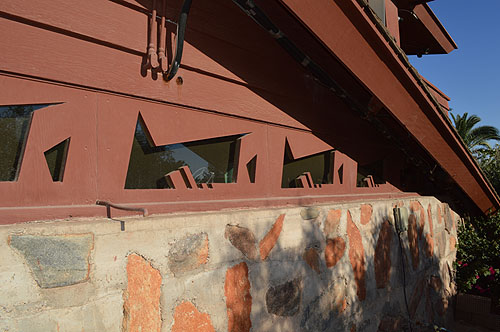 |
| 15)
Jorgine Boomer Residence viewed from the Northwest, April
15, 2014. Perforated light screens top the walls of the
Dining and Work Space, adding a measure of privacy. The
concrete walls of the Work Space slant inward. (ST#2014.07.1014-15) |
| |
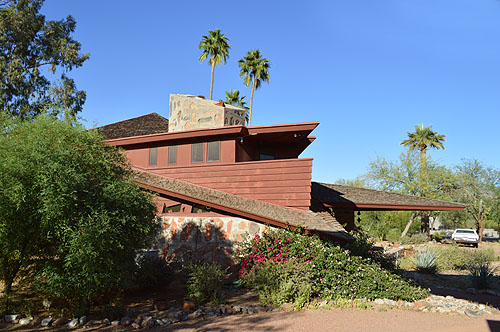 |
| 16)
Jorgine Boomer Residence viewed from the West, April 15,
2014. First floor: The Dining Area and Work Space (Kitchen)
are on the left, the Entrance and Chauffeur's quarter are
below the wide cantilevered overhanging eve on the right.
Upper floor: The expanded upper level was added prior to
1963. The concrete masonry core houses the bathrooms and
fireplaces on the first and second floors, and mimics the
same angle of the roof. Note the three palm trees in the
center background. They were first visible in the circa
1973-5 images (#2), which would make
them approximately 40 years old.
(ST#2014.07.1014-16) |
| |
 |
| (For
comparison: Jorgine Boomer Residence Circa 1956 showing the
original second level. Photographer unknown.) |
| |
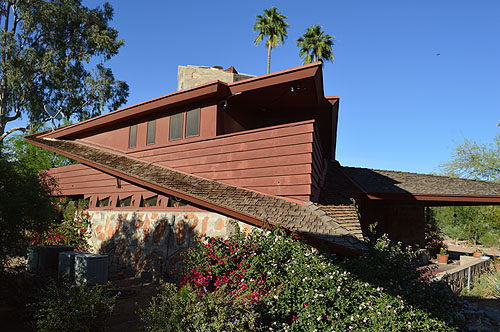 |
| 17)
Jorgine Boomer Residence viewed from the West, April 15,
2014. First floor: The Dining Area and Work Space (Kitchen)
are on the left, the Entrance and Chauffeur's quarter are
below the wide cantilevered overhanging eve on the right.
Upper floor: The expanded upper level was added prior to
1963. The concrete masonry core houses the bathrooms and
fireplaces on the first and second floors, and mimics the
same angle of the roof.
(ST#2014.07.1014-17) |
| |
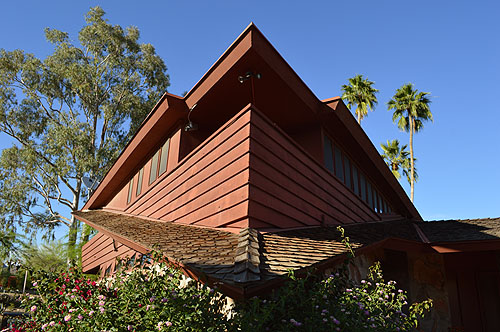 |
| 18)
Jorgine Boomer Residence viewed from the Southwest, April
15, 2014. Detail of the expanded upper level, added prior to
1963.
(ST#2014.07.1014-18) |
| |
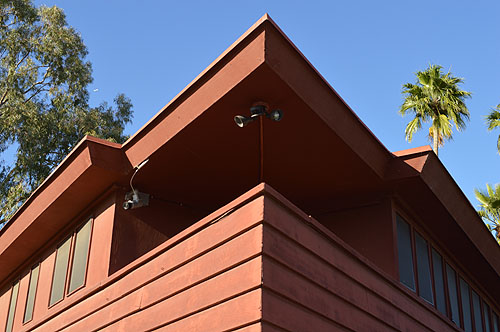 |
| 19)
Jorgine Boomer Residence viewed from the Southwest, April
15, 2014. Detail of the expanded upper level, added prior to
1963. (ST#2014.07.1014-19) |
| |
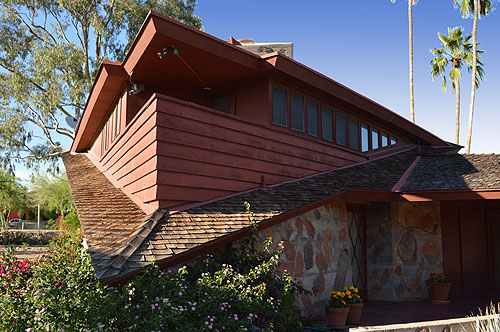 |
| 20)
Jorgine Boomer Residence viewed from the Southwest, April
15, 2014. First floor: The Dining Area and Work Space
(Kitchen) are on the left in the foreground, the Entrance
and Chauffeur's quarter are below the wide cantilevered
overhanging eve on the right. Upper floor: The expanded
upper level was added prior to 1963.
(ST#2014.07.1014-20) |
| |
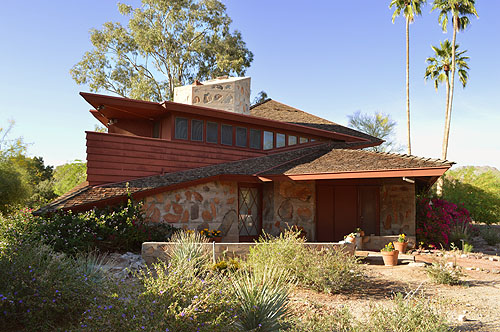 |
| 21)
Jorgine Boomer Residence viewed from the South, April 15,
2014. The home is anchored to the desert with walls that are
constructed of natural red desert stone set in concrete, in
the nature of Taliesin West. First floor: The Work Space
(Kitchen) is on the left, Entrance and Chauffeur's quarter
are to the right. Upper floor: The expanded upper level was
added prior to 1963. The home is dominated by the large roof
that begins in the rear of the home and rises, enhancing the two story home in front, then cantilevers out over the
cantilevered balcony. The concrete masonry core houses the
bathrooms and fireplaces on the first and second floors,
and mimics the same angle as the roof.
(ST#2014.07.1014-21) |
| |
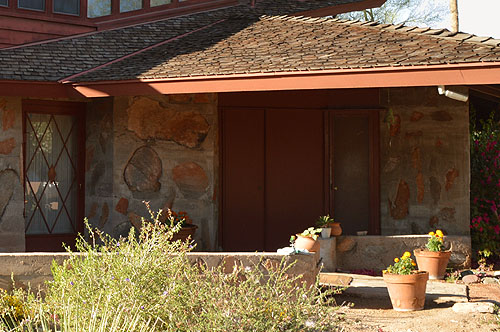 |
| 21B)
Detail of the Entrance and Chauffeur's quarter.
(ST#2014.07.1014-21B) |
| |
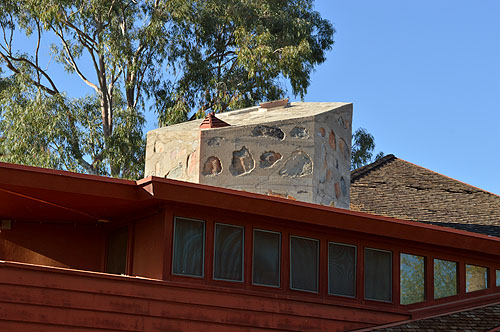 |
| 22)
Jorgine Boomer Residence, April 15, 2014. The concrete
masonry core houses the bathrooms and fireplaces on the first
and second floors, and mimics the same angle as the roof. (ST#2014.07.1014-22) |
| |
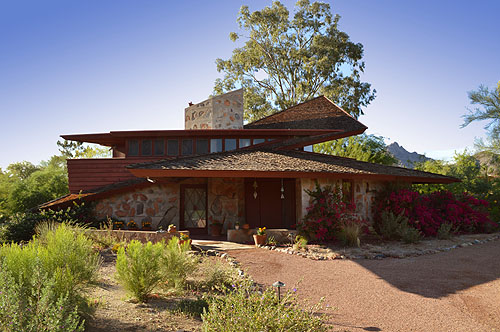 |
| 23)
Jorgine Boomer Residence viewed from the South, April 15,
2014. First floor: The Work Space (Kitchen) is on the left,
Entrance and Chauffeur's quarter are to the right. Upper
floor: The expanded upper level was added prior to 1963. The
home is dominated by the large roof that begins in the rear
of the home and rises, enhancing the two story home in
front, then cantilevers out over the cantilevered balcony.
The concrete masonry core houses the bathrooms and fireplaces on
the first and second floors, and mimics the same angle as
the roof.
(ST#2014.07.1014-23) |
| |
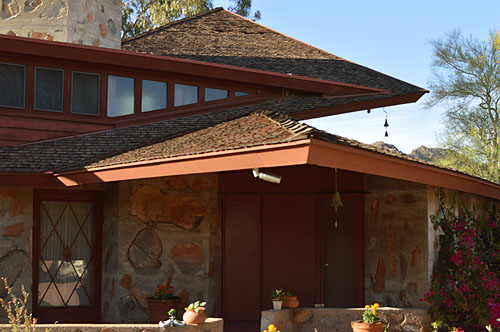 |
| 24)
Jorgine Boomer Residence viewed from the South, April 15,
2014. First floor: The Entrance is on the left, the
Chauffeur's quarter is to the right. Upper floor: The
stairway is to the left, the Sitting Room (Bedroom) is on
the right. The home is dominated by the large roof that
begins in the rear of the home and rises, enhancing the two
story home in front.
(ST#2014.07.1014-24) |
| |
| |
|
| |
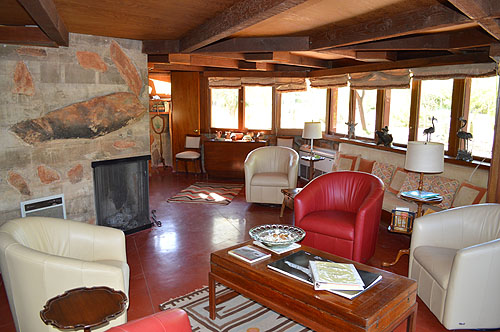 |
|
1) Jorgine Boomer Residence
interior, April 15, 2014. Viewed from the East end of the
Sitting Room. The entrance is to the left out of the
photograph. The concrete masonry core on the left is
constructed of natural red desert stone set in concrete and
houses the bathrooms and fireplaces on the first and second
floors. There originally was a wall that created a bedroom
at the far end of the Sitting Room. The built in seating
seen to the right occupied the removed wall between the
Sitting room and Bedroom. To the left of the windows, the
door leads to the Dining area and Work Space (Kitchen). This
was the only access to the bedroom. Half height windows look
out on the desert. Floor to ceiling windows and doors, on
the right out of the photograph, leads to the Lanai. The
redwood ceiling has open beams. Frank Lloyd Wright designed the
Boomer Residence on an equilateral parallelogram diamond
grid. The grid is imprinted into the "Cherokee Red" concrete
floor. (ST#2014.08.1014-1) |
| |
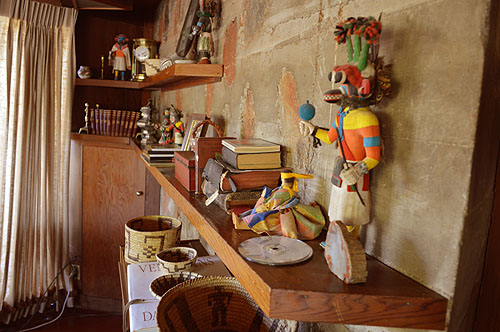 |
| 2) Jorgine Boomer Residence
interior, April 15, 2014. Floor to ceiling windows and
doors, on the left, leads to the Lanai. Cantilevered shelves
cover the concrete wall between the Sitting Room (on
the left) and the Chauffeur's Quarter (opposite side of the
wall). (ST#2014.08.1014-2) |
| |
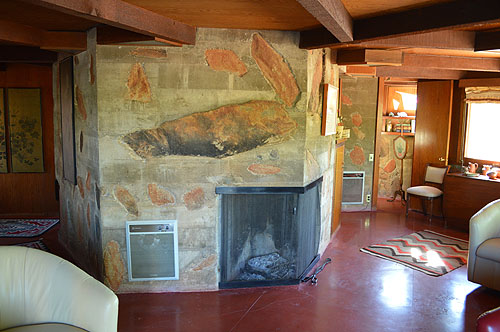 |
| 3) Jorgine Boomer Residence
interior, April 15, 2014. The concrete masonry core is
constructed of natural red desert stone set in concrete and
houses the bathrooms and fireplaces on the first and second
floors. The hall to the left leads to the Entrance, the
Workspace is accessed directly behind the concrete wall. On
the right, access to the Bath is between the fireplace and the doorway which leads to the Dining Area. The grid is visible in the
"Cherokee Red" concrete floor. (ST#2014.08.1014-3) |
| |
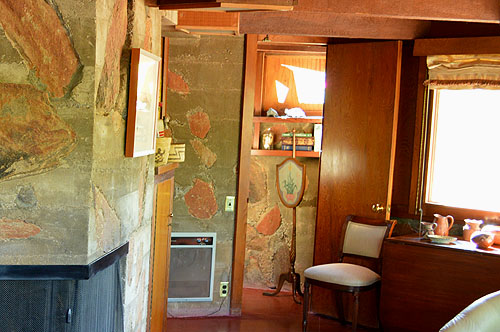 |
| 3B)
Detail: The Bath is between the fireplace and the doorway which leads to the Dining Area. (ST#2014.08.1014-3B) |
| |
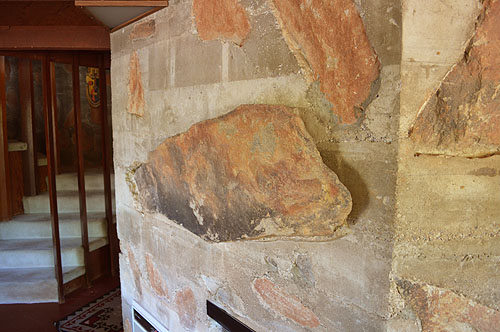 |
| 4) Jorgine Boomer Residence
interior, April 15, 2014. Detail of the natural red desert
stone set in concrete. The stairway on the left leads to the
upper level. (ST#2014.08.1014-4) |
| |
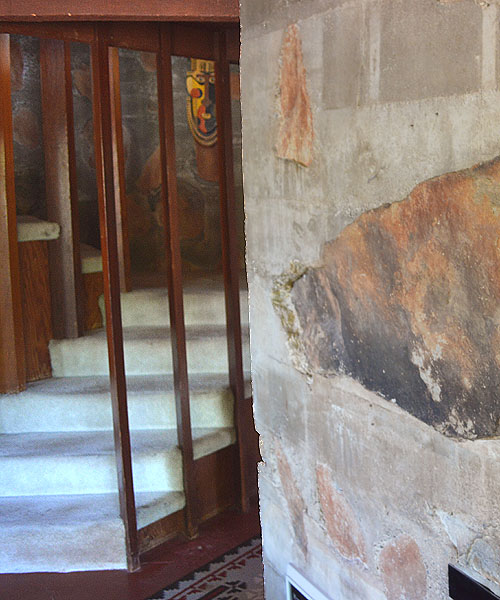 |
| 4B) Detail
of the stairway that leads to the upper level. (ST#2014.08.1014-4B) |
| |
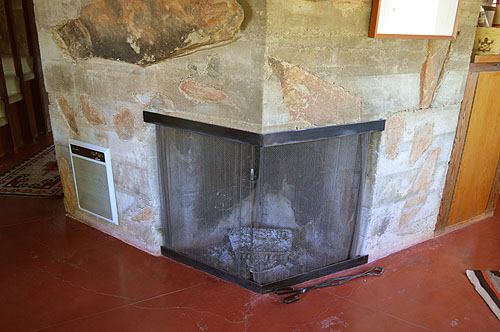 |
| 5) Jorgine
Boomer Residence interior, April 15, 2014. The concrete
masonry core houses the bathrooms and fireplaces on the first
and second floors. The grid is imprinted into the "Cherokee
Red" concrete floor. (ST#2014.08.1014-5) |
| |
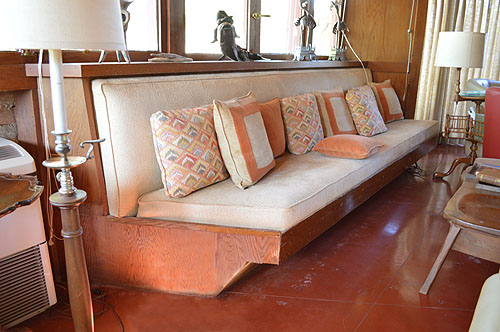 |
| 6) Jorgine Boomer Residence
interior, April 15, 2014. The built in seating originally
occupied the wall between the Sitting room and Bedroom. To
the left the windows look out on the desert. To the right,
floor to ceiling windows and doors leads to the Lanai. (ST#2014.08.1014-6) |
| |
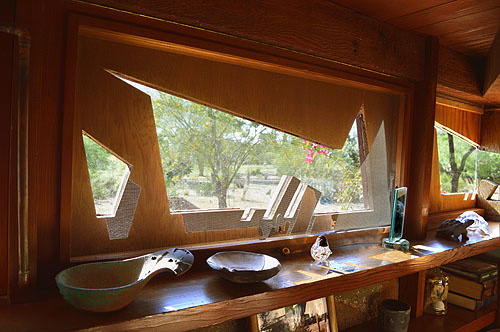 |
| 7) Jorgine Boomer Residence
interior, April 15, 2014. Perforated light screens in the
Dining and Work Space, adding a measure of privacy. Built-in
shelves cover the length of the outer walls. (ST#2014.08.1014-7) |
| |
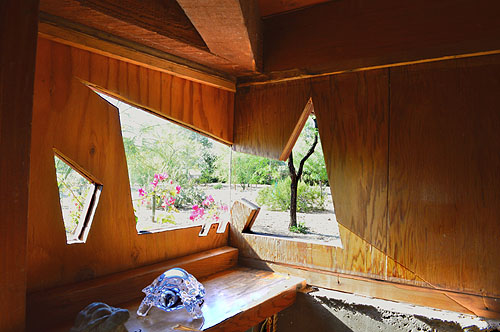 |
| 8) Jorgine Boomer Residence
interior, April 15, 2014. Detail of the perforated light
screen mitered glass corner in the Dining area. Built-in
shelves cover the length of the outer walls. (ST#2014.08.1014-8) |
| |
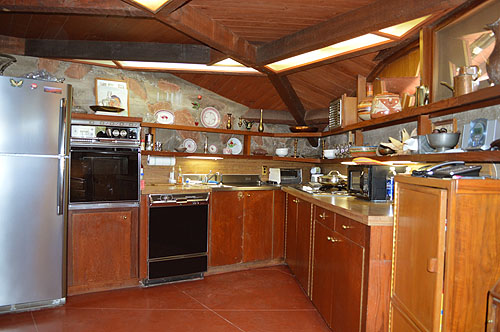 |
| 9) Jorgine
Boomer Residence Work Space (Kitchen). Built-in shelves
cover the length of the outer walls. Cabinets are built of
redwood. The grid is visible in the "Cherokee Red" concrete
floor. (ST#2014.08.1014-9) |
| |
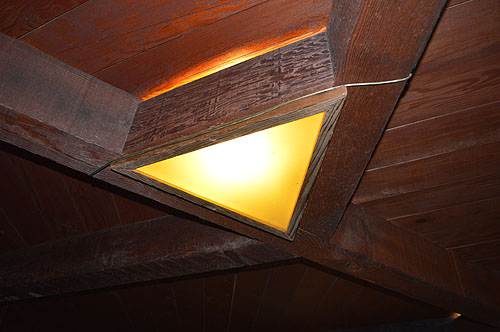 |
| 10) Detail
of the open beams and built-in lighting. (ST#2014.08.1014-10) |
| |
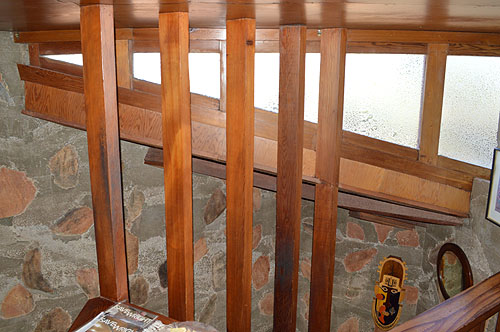 |
| 11)
Looking down at the stairway from the upper level. From the
lower level, the narrow winding stairway leads to the larger
Sitting Room (Bedroom), the smaller Maid's Bedroom and the
Bath. (ST#2014.08.1014-11) |
| |
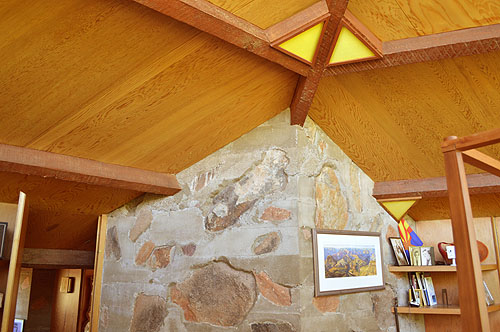 |
| 12) Jorgine Boomer Residence
interior, April 15, 2014. The concrete masonry core houses
the bathrooms and fireplaces on the first and second floors.
The ceiling rises from the Fireplace and cantilevers out
over the cantilevered Balcony. The doorway on the left opens
to the hall and stairway. (ST#2014.08.1014-12) |
|
|
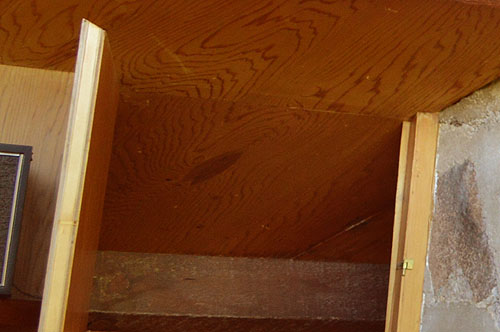 |
| 12B)
Detail of the door. The top is cut at the same angle as the
ceiling. (ST#2014.08.1014-12B) |
| |
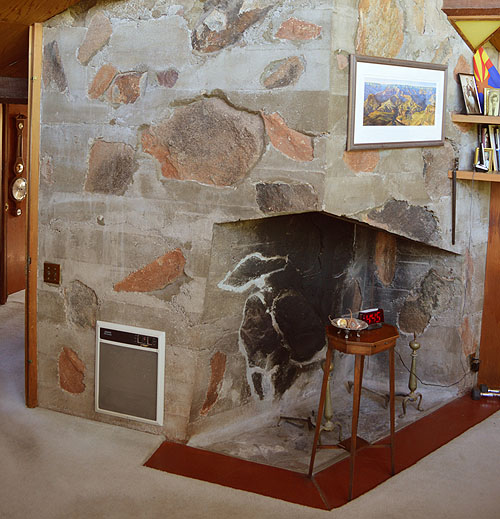 |
| 13) The
concrete masonry core houses the bathrooms and fireplaces on
the first and second floors. The doorway on the left opens
to the hall and stairway. (ST#2014.08.1014-13) |
| |
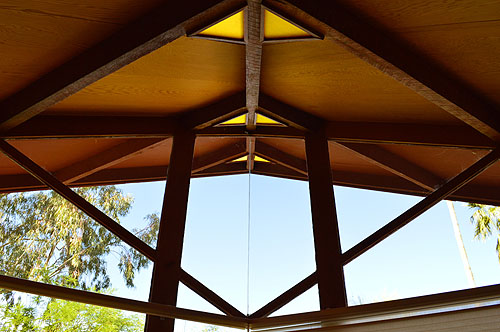 |
| 14) Jorgine Boomer Residence
interior, April 15, 2014. The ceiling rises from the
Fireplace and cantilevers out over the cantilevered Balcony.
Frank Lloyd Wright designed the Boomer Residence on an
equilateral parallelogram diamond grid. The grid is visible
in the pattern formed in the open rafters of the roof, the
sets of ceiling lights and designed into the top center of
the windows. (ST#2014.08.1014-14) |
| |
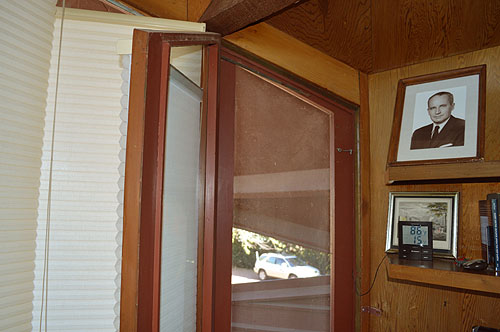 |
| 15) Doors
on either side of the Sitting Room (Bedroom) open out to the
Balcony. The doors are cut to mimic the angle of the
ceiling. (ST#2014.08.1014-15) |
| |
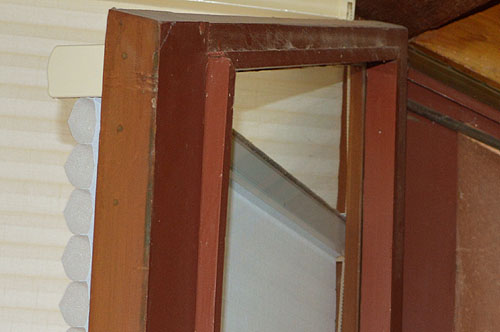 |
| 15B)
Detail of the doors that are cut to mimic the angle of the
ceiling. (ST#2014.08.1014-15B) |
| |
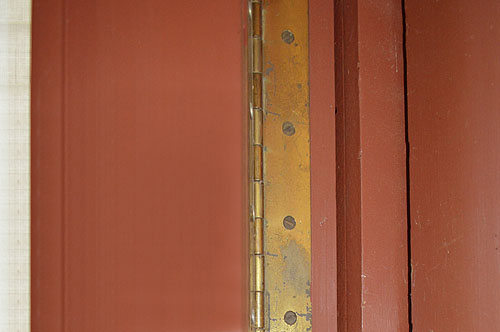 |
| 16) Frank
Lloyd Wright specified piano hinges on many of the doors and
windows in the homes he designed. (ST#2014.08.1014-16) |
| |
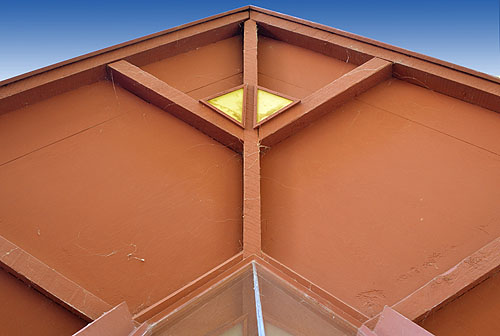 |
| 17) Viewed
from the Balcony looking up. Wright designed the Boomer
Residence on a diamond grid which becomes apparent in the
rafters and light fixtures. The glass corners are mitered. (ST#2014.08.1014-17) |
| |
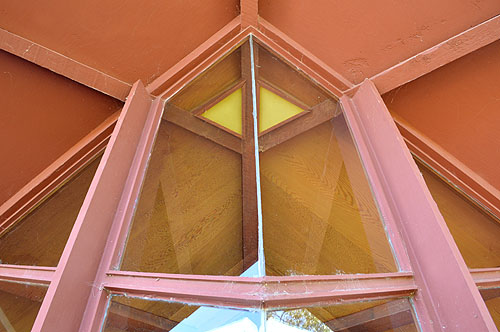 |
| 18) Jorgine Boomer Residence
interior, April 15, 2014. Viewed from the Balcony looking
up. The glass corners are mitered. Two by six inch boards
support the roof of the Boomer Residence. (ST#2014.08.1014-18) |
| |
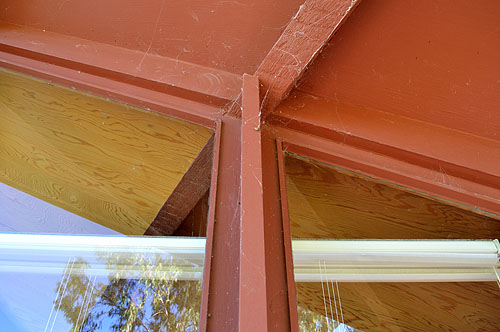 |
| 19) Detail
of the roof's support system. (ST#2014.08.1014-19) |
| |
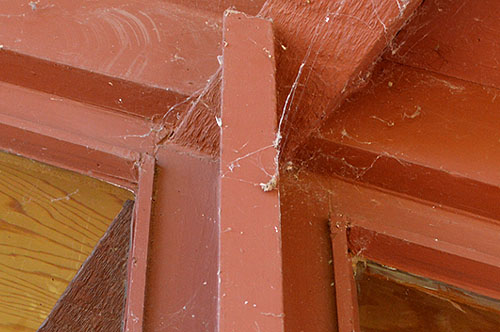 |
| 19B)
Detail of the roof's support system. (ST#2014.08.1014-19B) |
| |
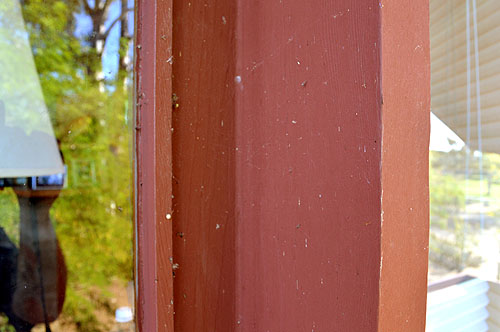 |
| 20) Detail
of the roof's support system. (ST#2014.08.1014-20) |
| |
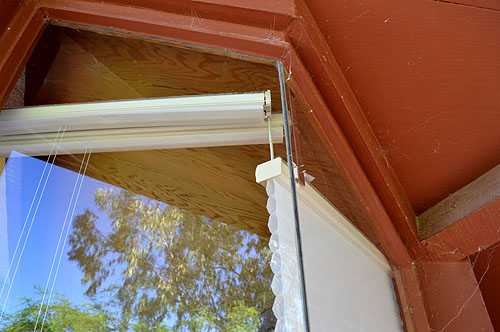 |
| 21)
Outside glass corners are mitered. (ST#2014.08.1014-21) |
| |
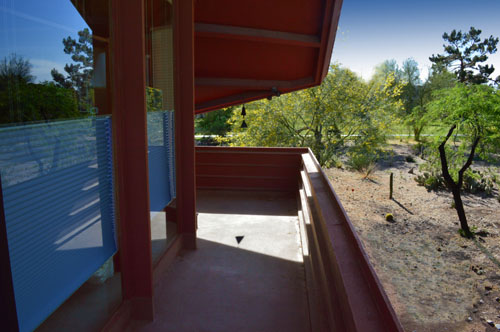 |
| 22) Jorgine Boomer Residence
Balcony, April 15, 2014. (ST#2014.08.1014-22) |
| |
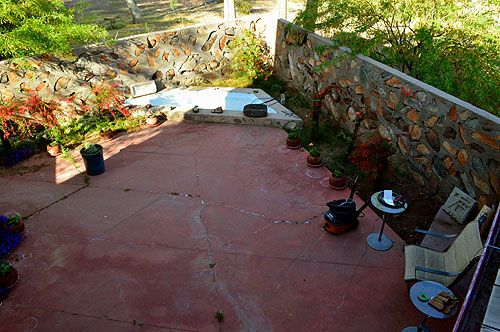 |
| 23) Jorgine Boomer Residence, April 15, 2014.
View of the Lanai from the Balcony. The grid is visible in
the "Cherokee Red" concrete patio. The fountain in the
background is a later addition. (ST#2014.08.1014-23) |
| |
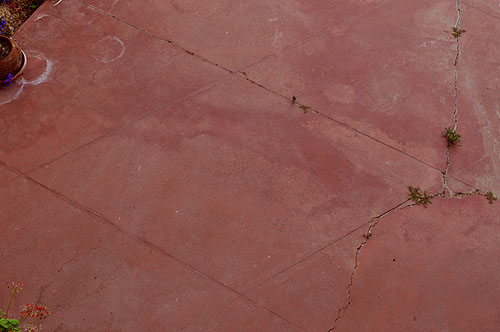 |
| 24) Detail
of the grid in the concrete patio. (ST#2014.08.1014-24) |
|
|
|

CLICK TO ORDER





































































































